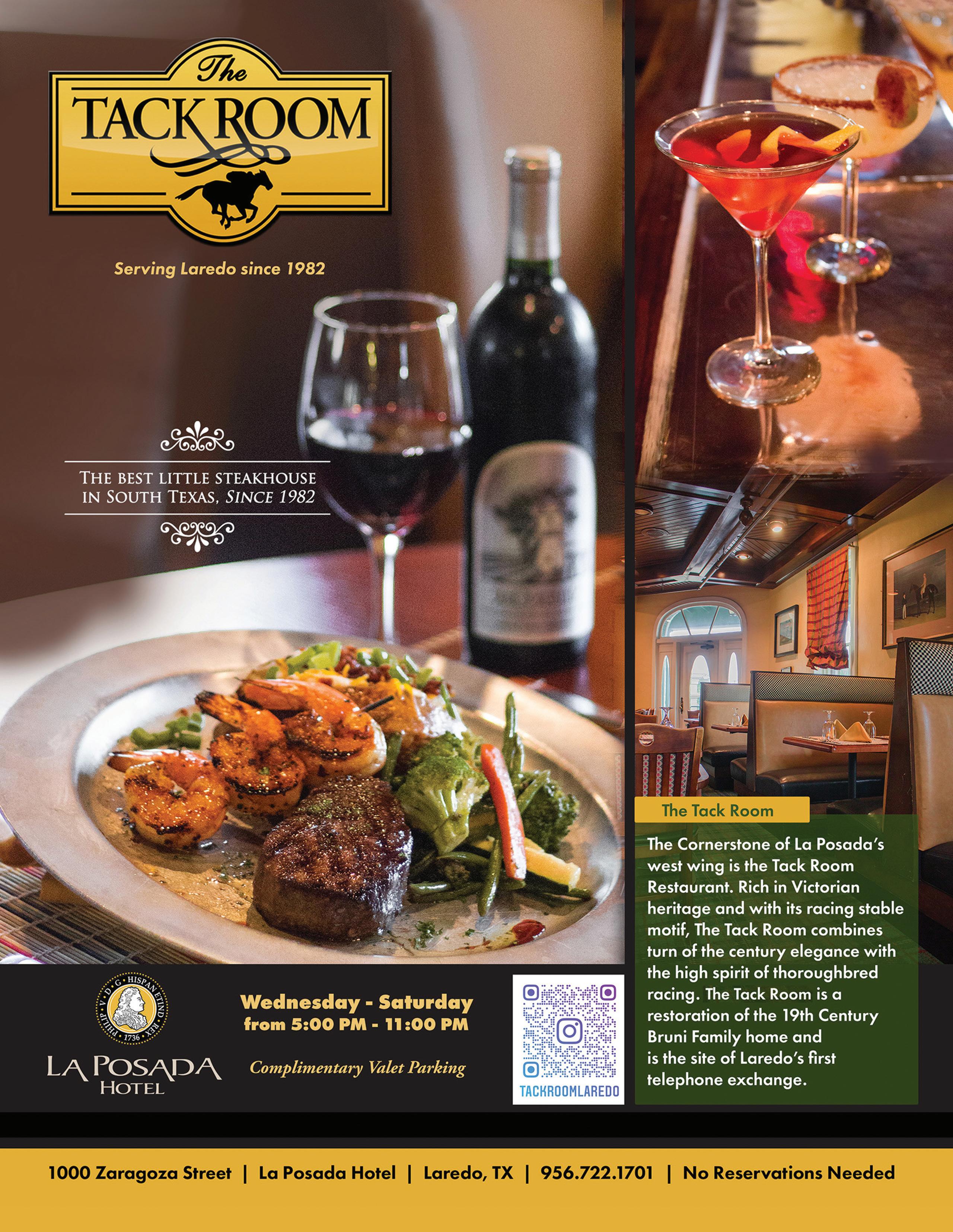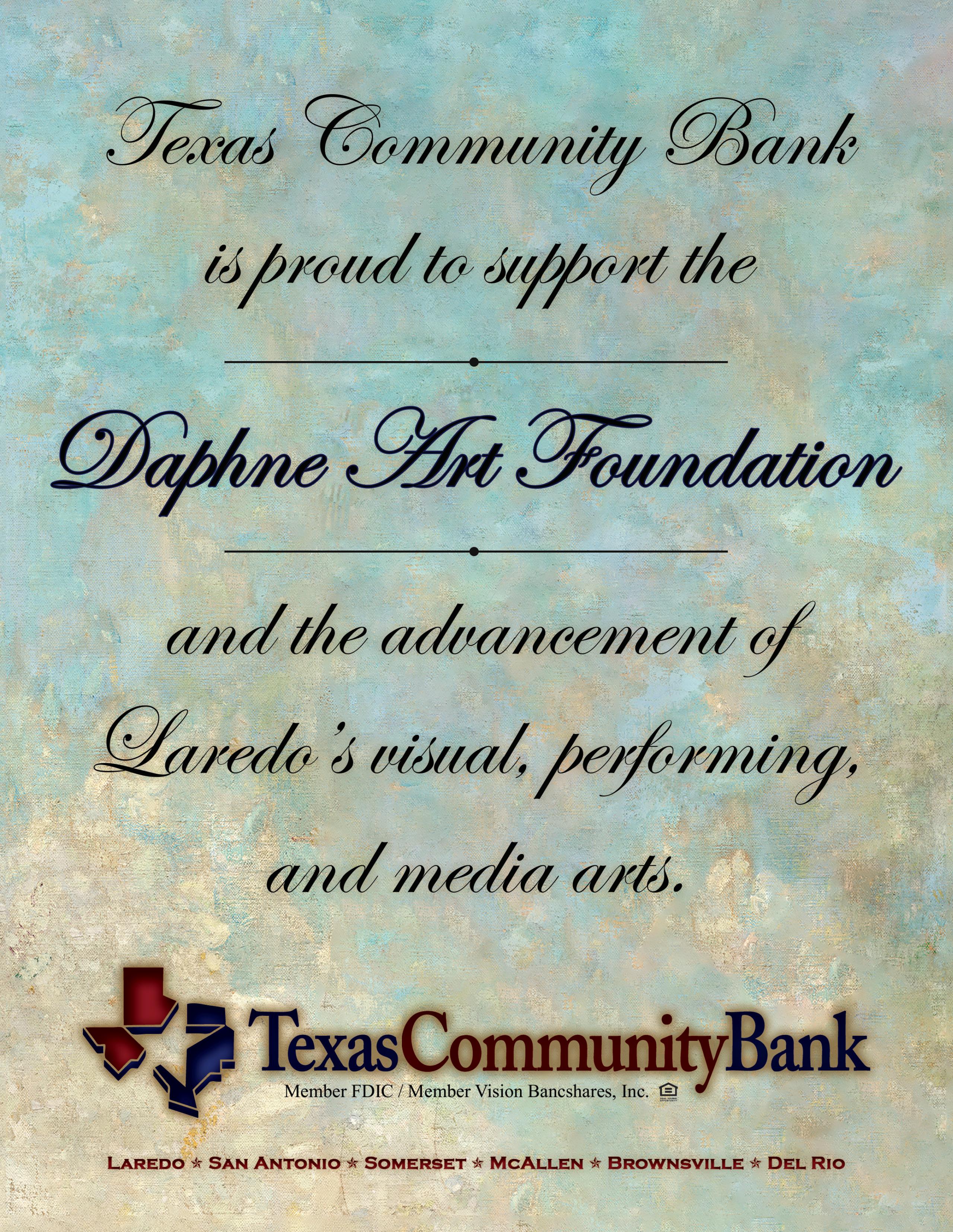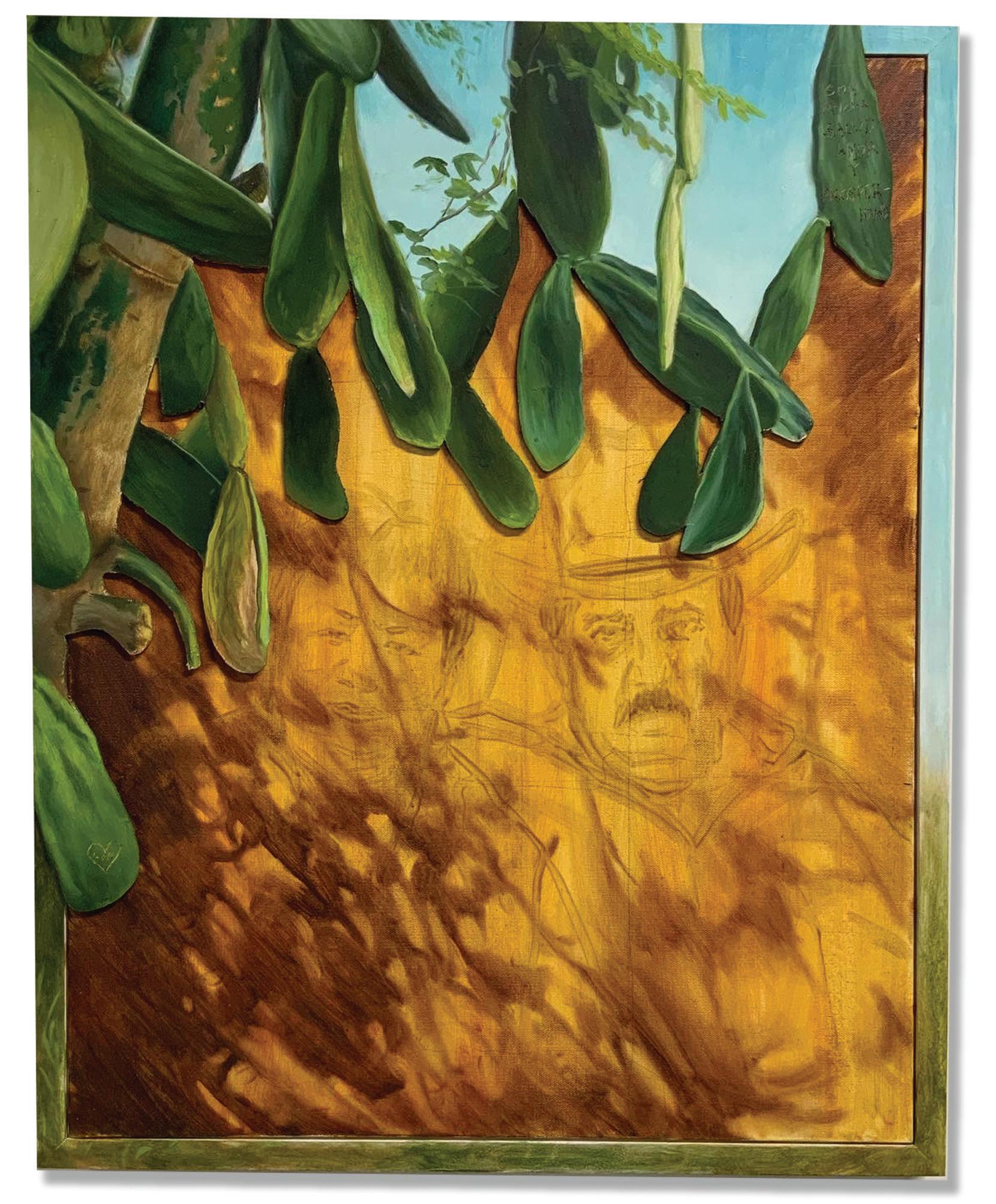
VOL. I • NO. 1 • April 2024 • A Borderland Journal of Arts and Culture
Jesus Treviño, Mensaje en la Penca
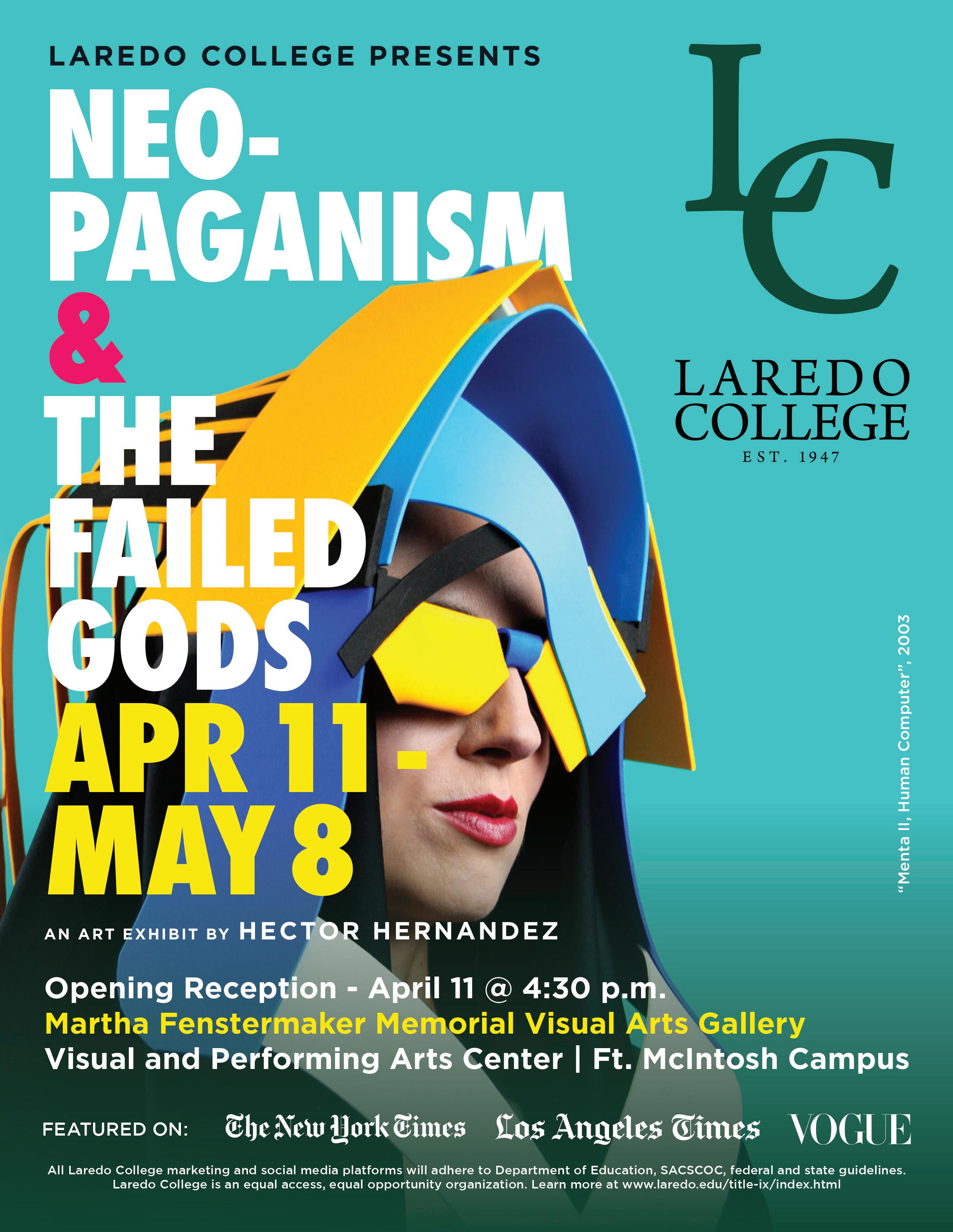
Meet , a quarterly journal of regional artists, their work, and the organizations that support them
BY THE DAPHNE ART FOUNDATION TEAM
Welcome to the latest initiative of Daphne Art Foundation (Daphne), TRAGALUZ, A Borderland Journal of Arts and Culture .
When Daphne emerged in 2019, the Laredo arts-scape evidenced artists existing in their unique isolation within a City economically thriving in international trade and making historic advances to become the #1 inland port in the nation.
As an organization dedicated to advancing the visual, performing, and media arts in our region, Daphne recognized the opportunity to bridge the gap between local artists and the community. We sought to create resources to help local artists navigate the creative landscape of our city, while simultaneously engaging and challenging them intellectually. We saw the value of bringing artists into the existing economic framework to foster entrepreneurship and to support their aspirations for self-actualization. We knew this required providing artists with the time and space conducive to focused work, a place in which they could be inspired to develop their artistic practices. It was then, and to this
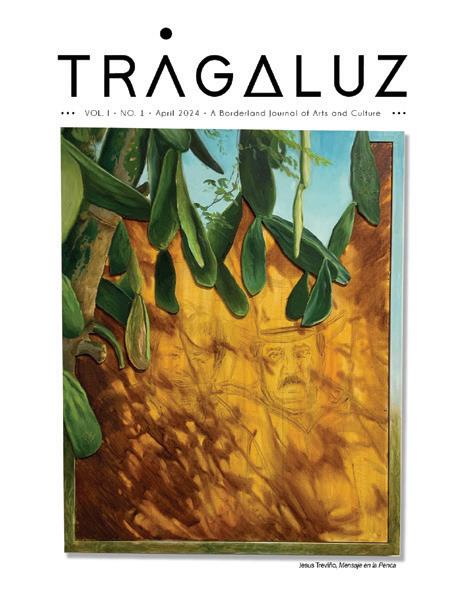
Jesus Treviño
Mensaje en la Penca (con mucha salud, amor, y prosperidad), 2023
day still is, essential to affirm their value to the community.
Daphne fulfills its mission by offering residencies to artists and creatives, exhibiting and promoting their work, and cultivating appreciation and participation in the arts.
Our vision is that the arts take their place central to our cultural and socioeconomic vitality. With the support of artists, collaborating arts organizations, art educators, higher education partners, and the community, we are a step closer to realizing that vision. The pages of TRAGALUZ evidence the progress we - all of us - have forged.
As you read through this first issue, consider what art is, who makes it, where and how art happens and exists, the stories art carries in all its manifestations, and its role in our own lives and the lives of those who create it. See beyond the illusion that art is solely an ‘out of town’ experience. The pages of TRAGALUZ are filled with stories of artists, art projects, exhibits, and cultural events that speak to the diversity and ever-growing fuerza of the multifaceted Laredo arts community.
Jesus Treviño on Mensaje en la Penca.
“Mensaje en la Penca is a painting made with used motor oil, polyurethane, and oil paint on canvas, framed with oil paint on hardwood masonite that was then carved into with a wood burner. Sourced from my uncle’s used car dealership on International Blvd. in Brownsville, the used motor oil, like the blood of a truck, contains the history of movement across borders in its DNA. Thinking of this material allowing a truck to access the ranchos in Matamoros, Tamaulipas, where my family is from, allows me to access the past when depicting this image of my aunt and uncle. This moment is interrupted by painted cacti. In the language of carving onto agave and cactus pads as a declarative act of love and in reference to the Vicente Fernandez song, “La Ley del Monte,” these nopalitos hold memory of affection and also declares my love for family members I’ve never met. This painting was made while I was part of CultivArte’s V-AiR program. This was my first attempt to combine varied materials, techniques, and tools that I have experimented with over the years.
- Jesus Treviño
APRIL 2024 3
COVER
A Program of Daphne Art Foundation
A Borderland Journal of Arts and Culture
P.O. Box 6238 Laredo, Texas 78042
Editor María Eugenia Guerra Writers Maritza Bautista María Eugenia Guerra Linda LaMantia Seyde García Ryan Cantu Design Vantage GFX
(956) 337-9115 info@daphneart.org
Laredo Cultural District aptly housed in Casa Ortiz, a historic architectural showpiece
Non-profit LCD offers art exhibits, music, dance, and screenings of classic Mexican films
BY MARÍA EUGENIA GUERRA
The Laredo Cultural District (LCD) makes its home at Casa Ortiz, an elegant, architectural showpiece at 915 Zaragoza in the San Agustin Historic District. This beautiful surviving nod to the past, was originally built as a three-room structure around 1830 – well before Texas claimed statehood - by rancher Don José Reyes Ortiz. Eventually, additions turned the modest home on the bluff facing the Río Grande into a two-story, 12,500+ square-foot residence graced with upstairs porches, stables, and a verdant courtyard. Casa Ortiz was recorded as a Texas Historic Landmark in 1964 by the Texas Historical Commission.
Attorney Lawrence Mann purchased Casa Ortiz in the early 1990s and lived there with his wife Catherine Ringwood Mann from 1995 to 2005. When the Manns moved to San Antonio, Webb County purchased the property and in return for its caretaking, allowed TAMIU use of the building for meetings, workshops, and entertainment events.
Casa Ortiz reverted to the County, and in 2021 it was leased to the newly formed Laredo Cultural District, a non-profit. According to LCD board member Jorge Santana, Casa Ortiz
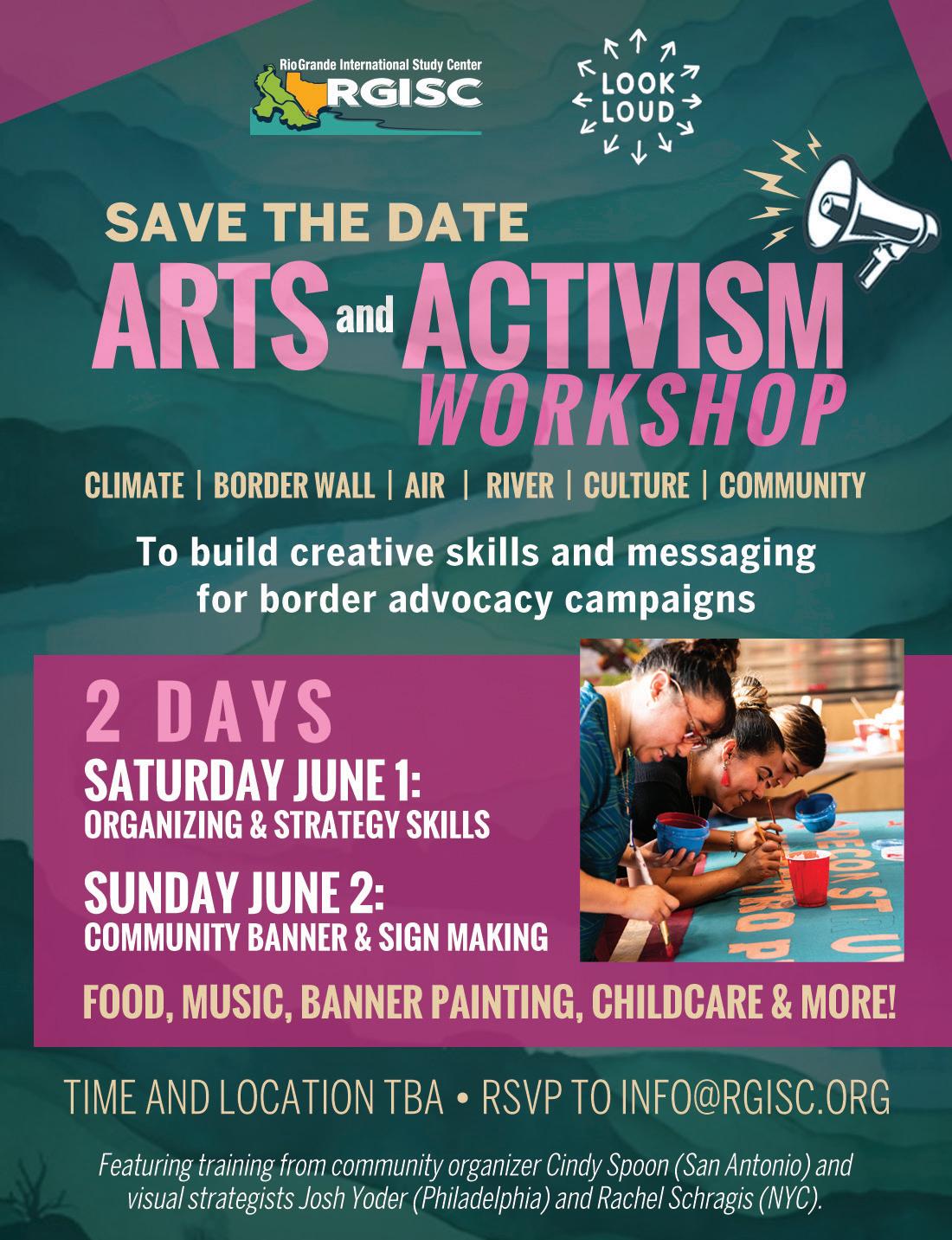
has been an excellent venue for the cultural enrichment of the community through art exhibits, musical performances, and the screenings of classic Mexican films from la epoca de oro
Santana said tours of the home are available by appointment, adding that Caminarte’s artwalk through downtown and beyond, is at the center of Casa Ortiz’s offerings. It is staged the first Friday of the month.
April 5th Caminarte originates at Casa Ortiz at 6 p.m. and includes stops at Los Olvidados, Gallery 201, the Laredo Center for the Arts, Casa Daphne, and Frontera Beer Garden.

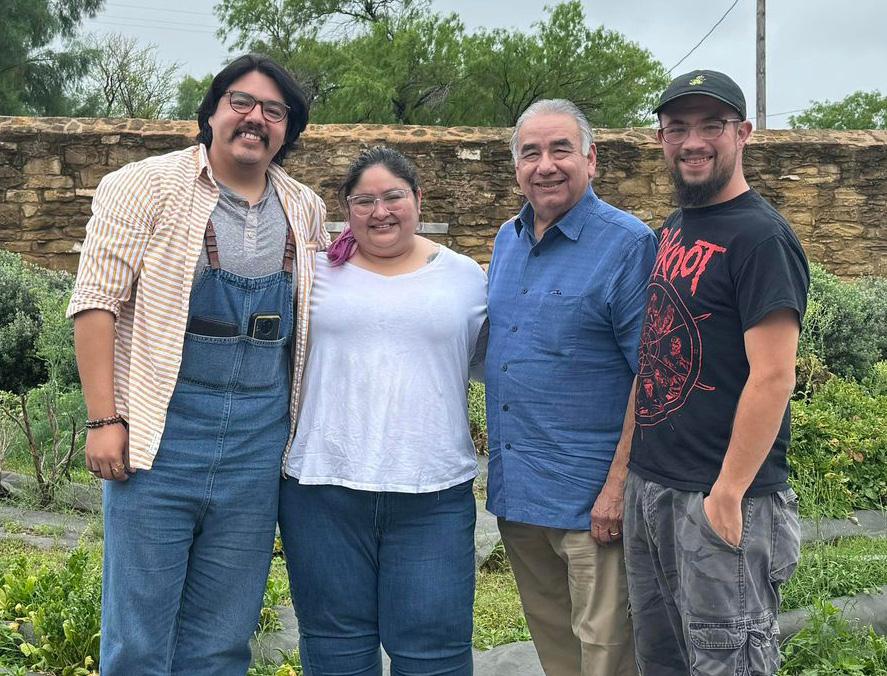
4 APRIL 2024
The poets Choriqueso, Ms. Bea, AXL, and Nobody are pictured at the recent Ninth Annual Poetry Under the Sundial in San Ygnacio. The event was hosted by the River Pierce Foundation.
(Photo courtesy of Sam Bratton.)
The power of art: to heal, to change us, to improve our quality of life, to speak in a way words alone cannot, to reduce depression
Art by the numbers: the arts have generated $6 billion for the Texas economy and almost $380 million dollars in state sales tax revenue; nearly 845,000 Texans are employed in creative careers.
BY LINDA LAMANTIA
Think back to the last time you were feeling low or inadequate or just in a slump. What brought you out of it? Was it a loved one? Or was it a song on the radio or a favorite TV show? Art has the power to change our emotions. To speak in a way that words alone can’t. To bring light where there is darkness. To bring smiles where there is sadness. To open our minds and hearts to new ideas.
Art has the power to do so many positive things. In fact, the arts bring money to our community, bolstering our economy. The Arts bring us together socially through cultural events: concerts, movies, openings and exhibits, improving our quality of life. The arts can improve students’ tests scores and impact graduation rates and college acceptance. The arts enhance our workforce. And the arts have the power to heal physically, mentally, and emotionally.
Art by the numbers (from the Texas Cultural Trust - TXCT):
• The Arts and Culture industry has generated over $6 billion dollars for the Texas economy and almost $380 million dollars in state sales tax revenue.
• In Texas, nearly 845,000 people are employed in creative careers, which represents 1 in 15 jobs.
• Attending just one cultural event a month can reduce the
risk of developing depression by 48%.
• Music therapy can decrease post-traumatic stress disorder symptoms by 30%.
• Listening to a prescribed music playlist can improve blood flow through damaged parts of a stroke patient’s brain by 18%.
• Texas high school students enrolled in more arts courses had better attendance, higher pass rates on standardized tests, and were more likely to attend college.
As a proud Laredoan, Board member of Daphne Art Foundation, founding member of the Laredo Cultural District, and Board member of the Texas Cultural Trust, I want to underscore the important work of our local arts organizations as well as that of our arts educators in our schools, and the need to adequately resource and support arts programs. From visual arts, to music, literary arts, and theatre, the arts are an essential component of not only a child’s personal, academic, and socio-cultural development, but an essential component of our quality of life.
Attend that theatre performance. Show up for the next art opening. Go to that concert. Participate in poetry readings. Join a book club. Do it for yourself! And do it for our budding artists. You won’t regret the benefits you’ll receive!
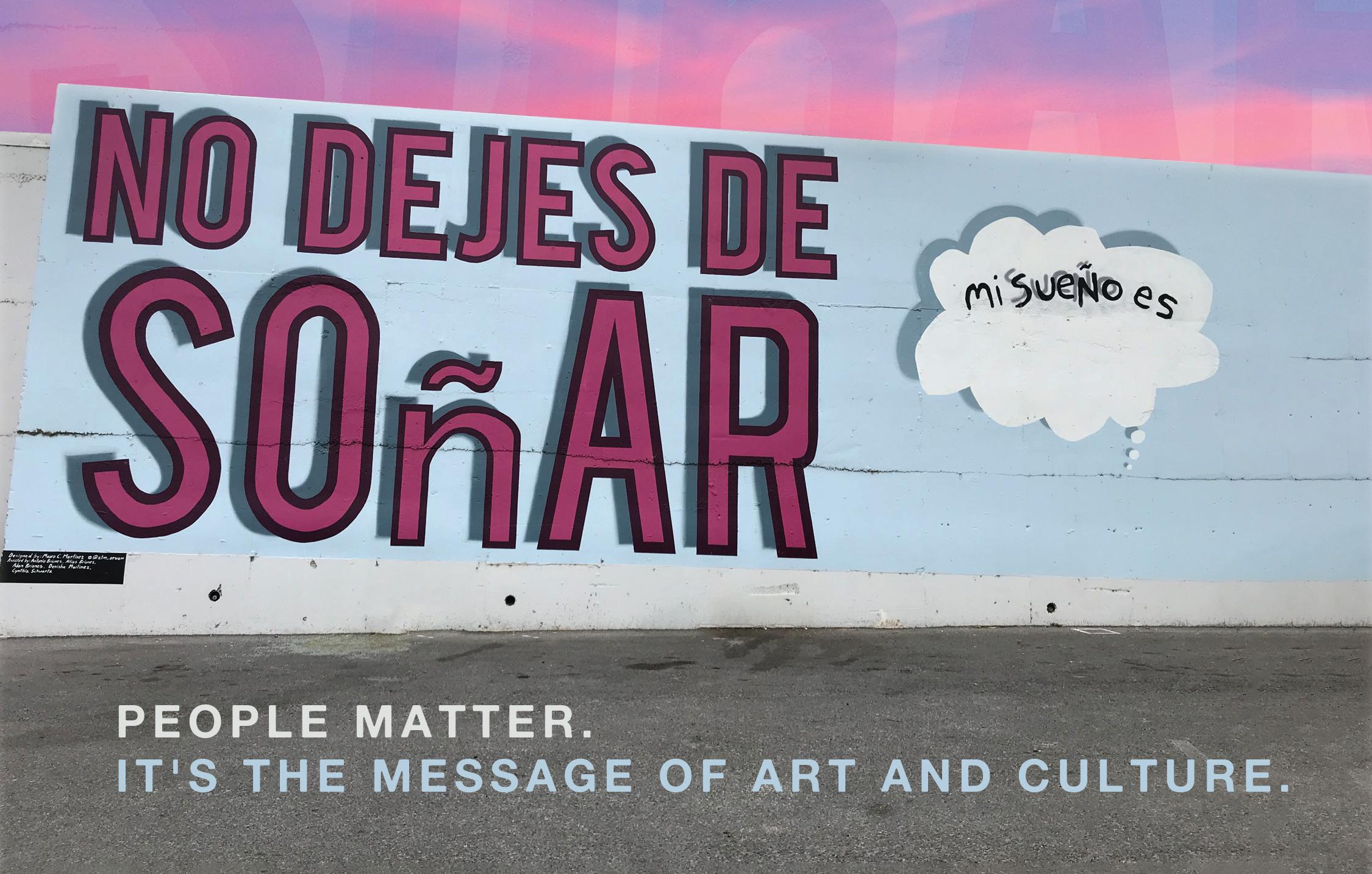
APRIL 2024 5
MURAL BY MAURO MARTÍNEZ.
A living corrido of joy and struggle on the Borderlands: the two-part exhibit of Cruz and Olivia Ortiz
When the live mariachi band filled the high-ceiling gallery with music, the world within the painting and the party outside seemed to cross the border of the canvas and mix into a perfect combination of art and life.
BY RYAN CANTU
“La mujer no busca, atrae. Y el centro de su atracción es su sexo, oculto, pasivo. Inmovil sol secreto” - Octavio Paz.
The Laredo Center for the Arts’ spring exhibit is a two-part exhibit featuring Cruz Ortiz in the downstairs main gallery, with Danza de Los Fantásticos y El Super Mix. Upstairs in the mezzanine is an exhibit by his wife Olivia Ortiz, Cosmic Lines; From There to Here.
The whole exhibit is a living corrido of highs, lows, joys, and tragedies that coexist in the lives of la raza en la cosmic frontera. Downstairs, images of late-night pachangas or women at the salon are set aside with the Farmworker strike in Crystal City or the tragedy in Uvalde. Even when his subjects are serious, Cruz’s subtle strokes of terracotta and light blues, some on loose flowing unstretched canvas, create a pleasant fever-dream quality that disarms and attracts the viewer.
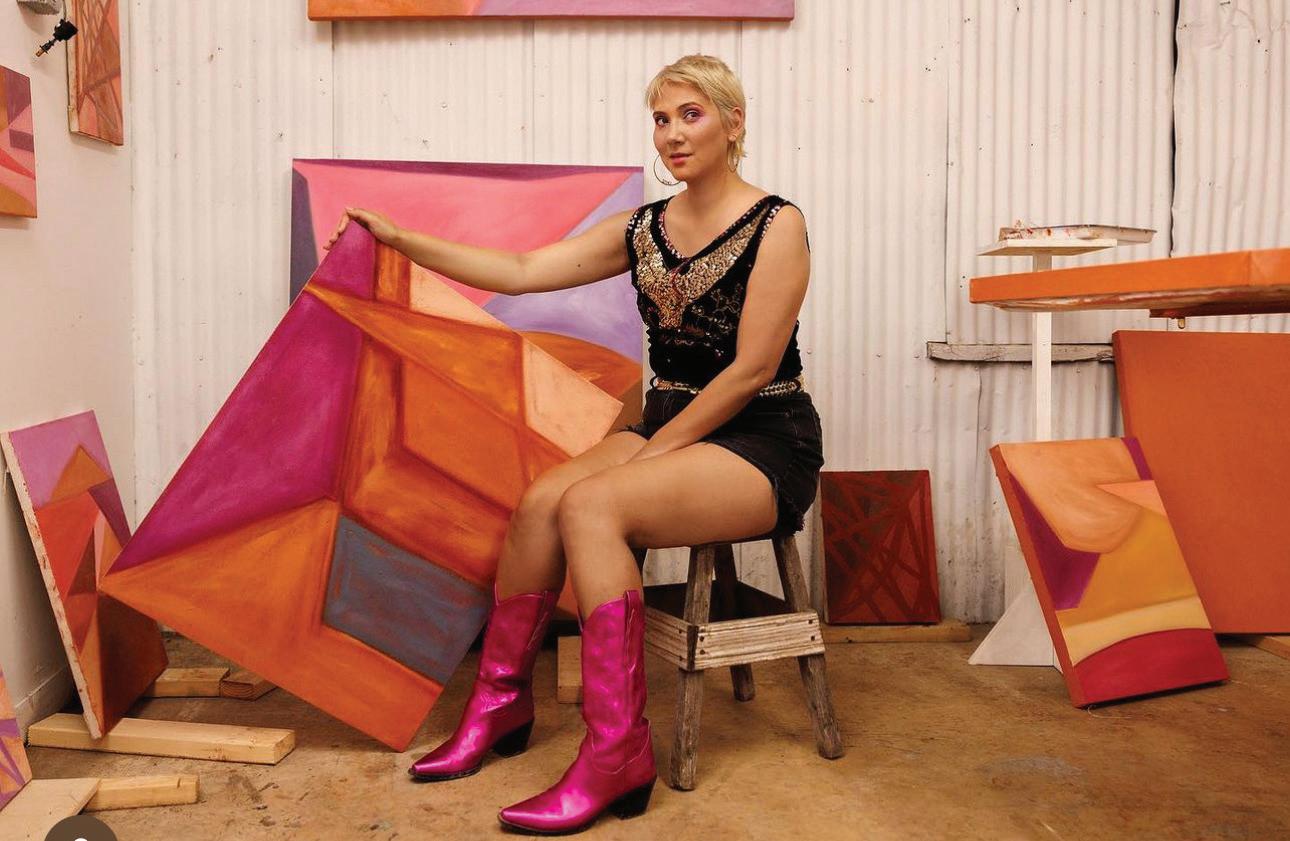
The festive energy of opening night on March 1 was neatly captured in Cruz’s surrealist 60’’ x 72’’ oil painting “El corrido de cuando when we partied in Laredo.” When the live mariachi band filled the high-ceiling gallery with music, the world within the painting and the party outside seemed to cross the border of the canvas and mix into a perfect combination of art and life.
Borders was the theme of both exhibits, but in a way that the border is rarely portrayed. Cruz describes it “not as the line between masses but the gap as a cosmic center. Rejecting la frontera as a peripheral existence and announcing fronterizmo as a series of mega-epicenters, como fluid filled pulsating muddy earthen vertebrae sprouting with plantas and river animalitos.”
While Cruz rejects the border as a peripheral concept altogether, Olivia’s work upstairs discusses borders beyond the physical: the invisible, the emotional, and the societal that constrain women on both sides of the physical border.
Olivia Cruz explains how the two exhibits are tied together by cosmic themes inspired by El Laberinto de la Soledad by Octavio Paz.
“Paz mentions in his essays the cosmic, and from ‘there to here’ came later, because my show is very personal, but it’s also universal,” she said. “Women in our lives are constantly evolving. “From there to here” talks about from young girl to career woman, career woman to mother, mother to a retired woman. My work is universal because it speaks to all of those evolutions. We all have a shared experience under patriarchy.”
Her triptych piece on the right wall walking up the mezzanine embodies this universal experience that triggered an emotional response in some women viewers. Winding through and jumping across the three squares are bright red lines that look cool and electric from a distance but transform into a violent and bloodlike quality as you approach and see the blown-up protective order that she had to obtain against an abusive ex-boyfriend in 2005.
Even when Olivia does cover traditional border themes like the ongoing migration crisis, it is done in an unconventional abstract way. I Am Not Your Governor, is a large abstract oil on canvas that disarms with its warm and earthy tones that spread and radiate, but as she explains, the work is based on the tragedy of a mother and her children drowning after being caught in Greg Abbott’s buoys in Eagle Pass.
“The beige that you see is what I imagine the buoys to be, and it’s open like a mouth, and you are entangled. You see a torso and breast in the blues of water, light pink velvet that looks tender, and you want to touch it.”
“These were little girls that deserved life,” she said. “This honors them, this says that you’re not just a news story that I forgot about the next day with the next news story.”
Though Cruz and Olivia’s concepts of borders vary significantly, they often overlap in thoughtful ways that make it clear that this is a deep and collaborative relationship.
“Our palettes are organically crossing over,” Olivia said. “Those terracottas and peachy pinks are coming into his work. It’s fun to see.”
Laredo was honored to step into the surreal and colorful world of Texas’s own Frida y Diego.
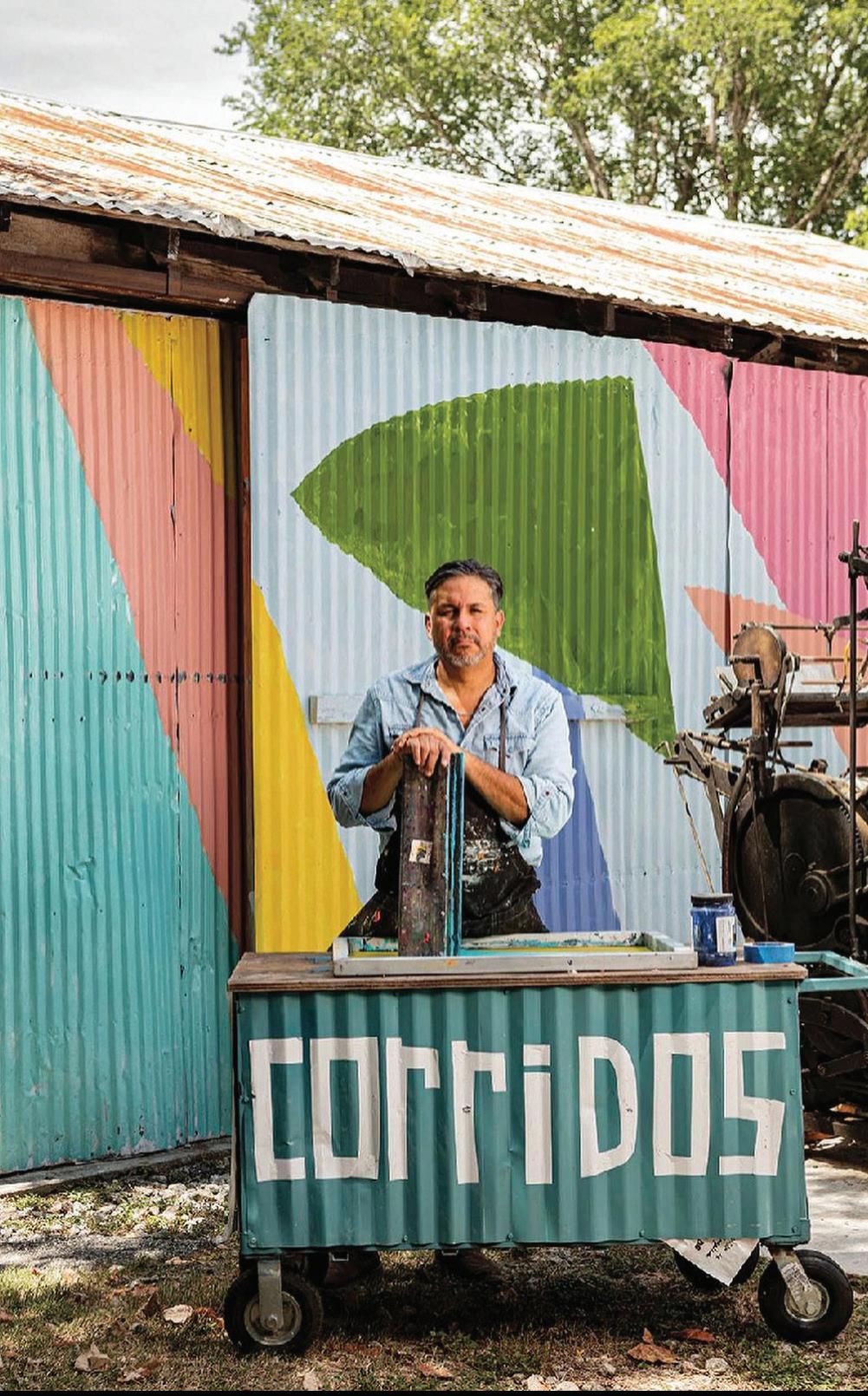
6 APRIL 2024
City’s Public Art Ordinance moves forward in baby steps
Lack of clarity about mangement of public art funds, why there haven’t been many new public artworks, and how artists can access funds for public art projects
BY MARITZA BAUTISTA
Long overdue and recorded as the first established, dedicated funding source for public art in “Laredo’s history,” Ordinance 2019-O-177 has been celebrated as a triumph for the arts community.
It is very significant.
For Daphne Art Foundation, this was a moment of success, underlining its formation as an arts nonprofit organization and contextualizing the kind of work it would undertake to serve the people of Laredo. Daphne (known as Cultivarte Laredo at the time) advocated and helped pass the ordinance along with a group of local artists and arts advocates.
While promising and optimistic in all of its 11 pages, the Ordinance’s steps moving forward are baby-like. The City did take a crucial step afterwards and hired consultants to design the Laredo Public Arts Master Plan (LAMP, 2022). The mission of LAMP is to “enhance our community’s attractiveness, grow and capitalize on our arts and culture sector, create opportunities for local artists, and build a collection of high-quality public art.”
LAMP serves as a “road map” with policies and recommendations to aspire, create, maintain, and conserve the City’s permanent Art Collection, one that will “promote artistic development of the city… and expand the experience and participation of citizens with visual arts” (Ordinance No. 2019-O-177). LAMP covers a lot of groundwork like program administration, collection management, five- and ten-year strategic plans, a summary of survey responses, recommendations, and priorities identified by council members, among so much more.
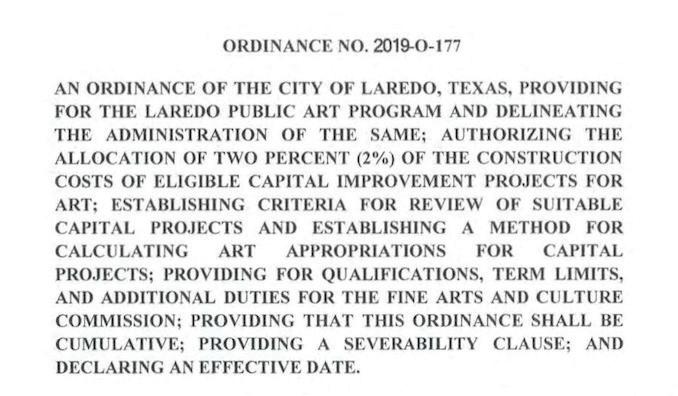
Seven years ago, City Council moved to create the Fine Arts and Culture Commission” (FACC), composed of nine appointed members, actively engaged for their input, expertise in visual art, and community relationships. (Full disclosure, I am on the FACC. I was appointed to represent District 8 and am one of the newest members.) The commission is currently assigned to the Library Director and meets once per month to serve as advisors
and make recommendations to City Council for matters in the arts.
The FACC recently reviewed applications to select and recommend the City of Laredo’s 2024-2026 Poet Laureate, Raquel Valle-Sentíes. Other projects the FACC recently discussed include the Lafayette Street Overpass mural project proposal and local selected artists (currently underway in the Canta Ranas neighborhood); a public art project that will show up as minimurals on utility boxes across all eight districts; and the TIRZ #1 (Tax Increment Reinvestment Zone) downtown mural arts program.
Things are moving… just slow.
There are challenges that keep things from developing. There are currently four vacancies on the FACC. Concerned citizens and arts advocates should reach out to their Council members and ask to be appointed or make suggestions.
The City still does not have a municipal public art program in place to administer the 2% funds, now at $800K. The lack of framework, practices, insufficient resources, and dedicated staff to administer the program adds to the dilemma.
Today, there are still many questions due to a lack of clarity about the public art funds and how they are managed, why there haven’t been many new public artworks, or how artists can access the funds for public art projects.
(Maritza Bautista is the Executive Director of Daphne Art Foundation.)
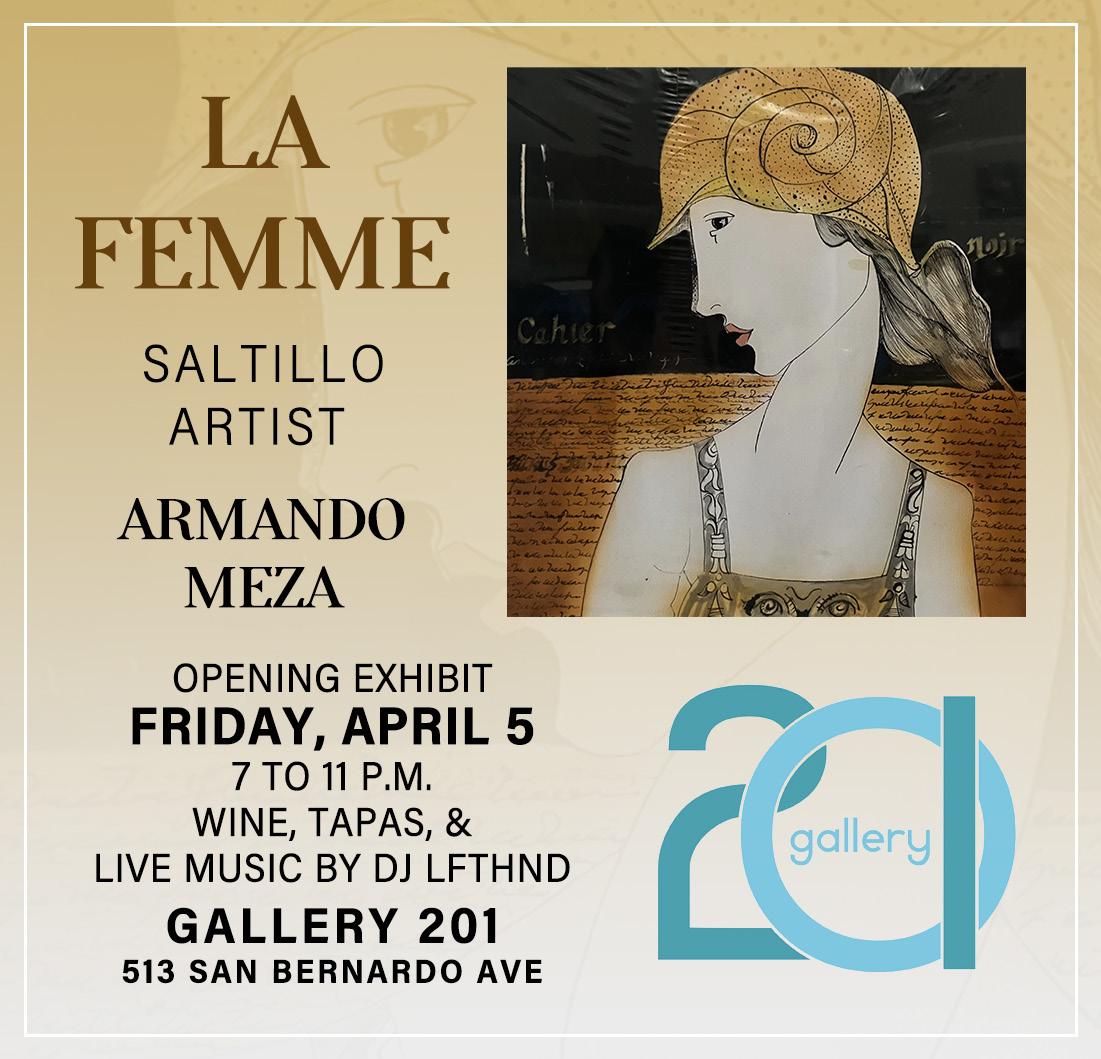
APRIL 2024 7
Caminarte: Downtown’s greatest art celebration. The heart of the City beats a little faster every first Friday
BY SEYDE GARCÍA
Every first Friday of the month, the heart of Downtown Laredo beats faster. The creative community and art lovers show up for a collective celebration of the arts in Laredo – Caminarte, a culturecrawl.
Since June 2021, rain or shine, every first Friday of the month, galleries, art spaces, bars and coffee shops have been diligent in scheduling art shows and activities intended for the community to gather, discuss, and enjoy art.
It’s my favorite day of the month. As a border child, and engineering graduate, I did not have many options to see art. I even lacked friends with whom I could talk about the things that amaze me. Caminarte has been a space that re-connected me with friends and introduced me to new ones with whom I share the love for art and our community.
I started attending in November 2021 by myself. In March 2022, during Ana Hernández’s exhibition “Code Switching” at Laredo Center for the Arts, I saw, after many years, who I now name my ultimate artsy gal: Keyla, at the other side of the gallery. Since then, we don’t even need to text or make an appointment to meet up at Caminarte. We haven’t missed a single one. ‘’Kaliarte’’ as we kindly call her, wears the best outfits matching the art pieces we will see.
I’m inspired by younger artists who show up with their craft both unapologetically and honestly, and now, brave enough to call myself a writer, commit to my duty. After 10 years of writing in my notebooks - just for myself - I presented my first collection as an author in September 2023 at Los Olvidados, a coffee shop that since its opening has been a place of gather for creatives, giving a space to showcase their work. It’s where many of my articles have been written.
A few weeks later, on my birthday, I wanted to celebrate with the people who have given me so much life. On the last Friday of the year (not the first) I invited two of my favorite bands and some of the visual artists who have inspired me. I set up an art show at Jardin Contreras, owned by art enthusiasts and supporters Chris and Val Contreras, and called it, poetically, “The rebirth of Venus” because this is how it feels since I’m part of this community of the arts. Like a rebirth in all that Venus is about: beauty, love, and
creativity.
Caminarte, with the help of all the people who have joined this celebration - artists, cultural workers, advocates, patrons, and business-owners - has become a safe space for the community that is experiencing and creating a collective awakening that is fully blooming.
In this world that seems at times meant to be destroyed, creating art is an act of rebellion. I invite you to be a rebel. Be part of this beautiful community. You need only to show up.
Start at Casa Ortiz at 915 Zaragoza St., and then head out to:
• Los Olvidados, 309 Flores Ave.
• Gallery 201, 513 San Bernardo Ave. On view: La Femme by Armando Meza.
• Laredo Center for the Arts, 500 San Agustin Ave. On view: La danza de los fronterizos y el super mix by Cruz Ortiz and Cosmic Lines by Olivia Cruz until May 3, 2024.
• Daphne Art Foundation, 1420 Washington St. On view: Cards in the Air by Leah Patgorski until May 24, 2024

8 APRIL 2024
ESSAY
Seyde at the Mezzanine of Laredo Center for the Arts. On the wall, artwork of Ana Hernández.
LTGI’s Matilda the Musical opens July 18 at TAMIU’s Center for the Fine and Performing Arts
Auditions are April 20- 21 for Tony award winning play
BY MARÍA EUGENIA GUERRA
The stage of the TAMIU Center for the Fine and Performing Arts comes to life Thursday, July 18 with the opening of the Laredo Theater Guild International’s (LTGI) production of Matilda, the Musical.
Roald Dahl’s 1988 novel Matilda has twice been made a movie. The 1996 adaptation starred Danny De Vito and Rhea Perlman as used car salesman Harry and housewife Zinnia Wormwood, the negligent, self-absorbed parents of Matilda, a child with an intellect far sharper than her parents and gifted with justice-seeking telekinetic powers.
The musical iteration in film was released in 2022 and starred Emma Thompson as the cruel school headmistress, Miss Trunchbull, a javelin-throwing former Olympian who considered children “revolting.”
The Royal Shakespeare Company’s performance of the musical on Broadway won five Tony awards in 2013. It continues onstage in London.
LTGI’s Henry Mejia and Jessica Verastegui are the producers of the local performance. Karol Ann Batey directs it. The months leading up to the July 18 opening night performance will include auditions, rehearsals, choreography, and wardrobe
and set designs. The play closes July 28.
“This production is a massive undertaking that will take hundreds of people to accomplish. We have secured the rights, rented the sets, and are in the process of setting up auditions on April 20 and 21 at TAMIU,” Mejia elaborated.
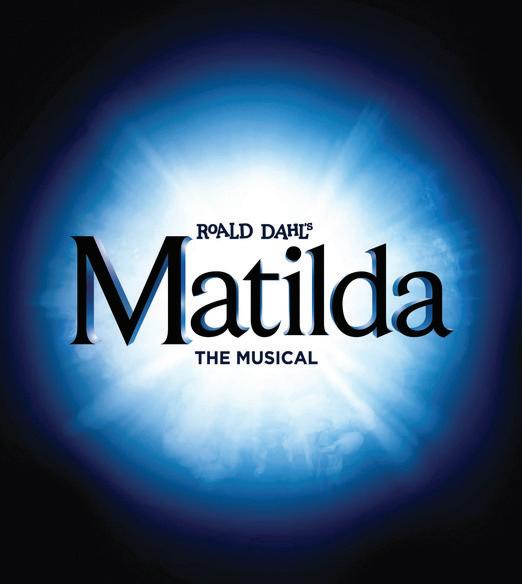
“There are 24 cast members. We are looking for six to eight children between 10 and 12 years old who can sing and move. Bobby López will be directing the live orchestra,” he continued, adding, “We had a good year with last summer’s The Little Mermaid, a hit that brought us out of the Pandemic drought and energized us. We are extremely excited about presenting Matilda the Musical.”

APRIL 2024 9
Gil Rocha
Featured Artist
BY MARITZA BAUTISTA
Artist, curator, and educator Gil Rocha (b. 1977, Laredo, Texas) earned a Master of Fine Arts from the School of the Art Institute of Chicago (2006) and a BFA from the University of Texas at San Antonio (1999). For the past 25 years, Rocha’s professional career has led him to engage in a variety of programs including workshops, panels, and public art projects with galleries and museums on the national and international level. Rocha works across painting, collage, sculpture, installation, and writing. He focuses on issues unique to the US-Mexico border and takes on a survivalist approach known as “Rasquachismo,” a term coined by Chicano scholar Tomás Ybarra-Frausto. Rocha’s avid advocacy for the arts has positively impacted his students, peers, and community.
Currently, Rocha is one of the lead artists of the Lafayette Street Overpass mural project, led by Houston-based UP Arts
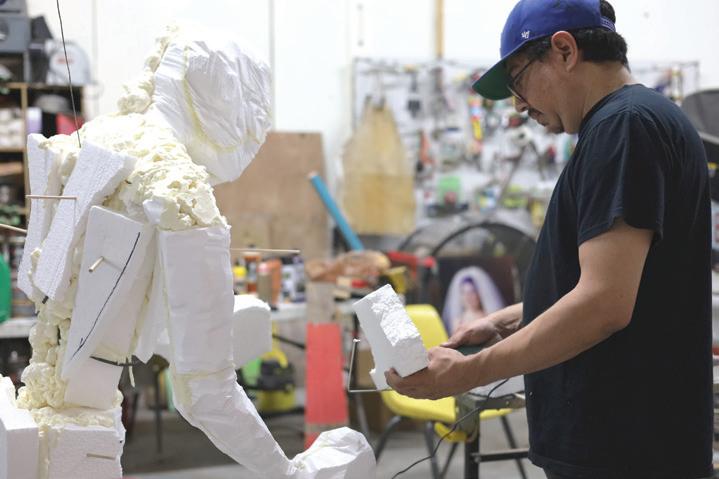

Studio. He will present an Art Lecture at Syracuse University in New York in mid-April. He is collaborating on a printmaking project with We Are Not Zombies (WANZ), a multi-cultural and multimedia movement based in Mexico City where he was also invited to facilitate a live art workshop this summer. His work will also be on view at the National Hispanic Cultural Center in New Mexico in June. The statewide survey of Latinx Art “Soy de Tejas,” curated by Rigoberto Luna, showcasing the work of 40 contemporary artists, including Rocha, will be on view at Arts Fort Worth until June 22. Rocha’s artwork will also be on view at the Mexic-Arte Museum during “Creating Encuentros: Changarrito 2012-2024” until August 25 in Austin. Soon, he will be developing work for his solo show at Kirk Hopper Fine Art in Dallas, slated for September. For more visit gil-rocha.com.

10 APRIL 2024
Esto Cala (This Hurts) Found objects
Approx. 16’ x 7’ x 3’ 2023
35” x 35” x 6”
Otras Fronteras Found objects
2023
Gil Rocha Photo credit, Maritza Bautista
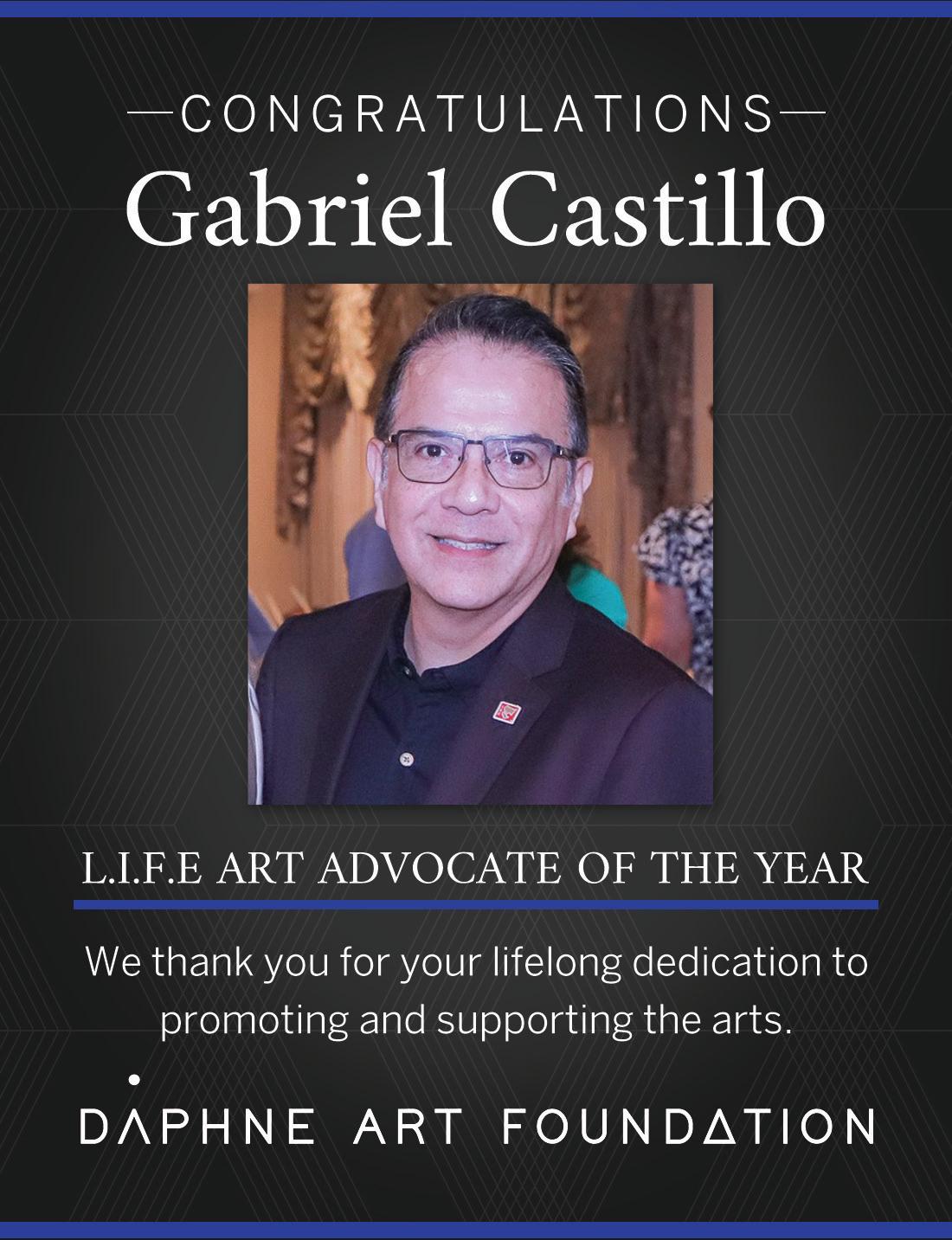
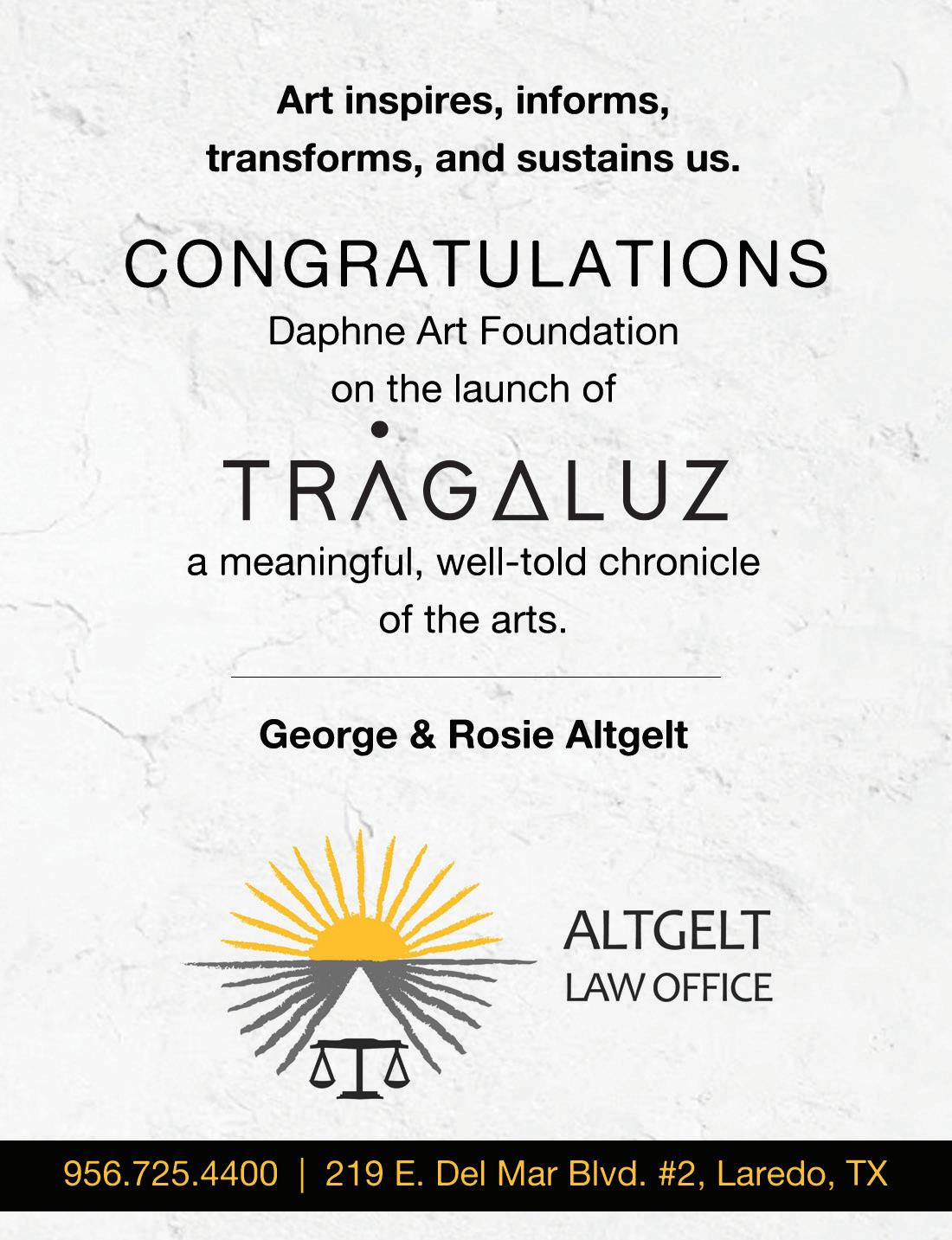
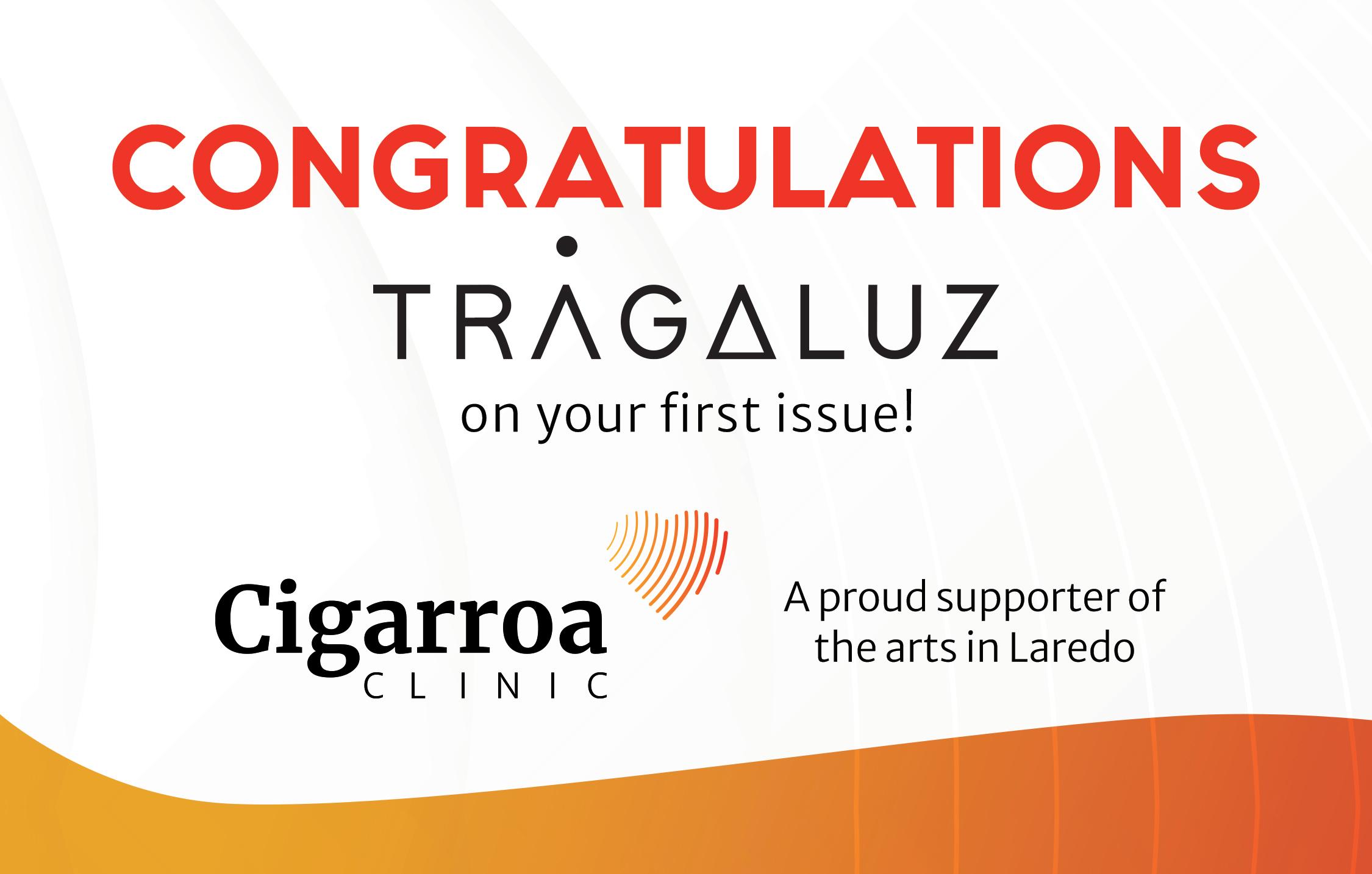
APRIL 2024 11
Weaving sustainability through art: the Rhizome installation and multidisciplinary project at Texas A&M International University
Rhizome represents the exploration of the interconnectedness between art, sustainability, and community engagement
BY CRYSTAL WAGNER
As a contemporary interdisciplinary artist, I have been fortunate enough to have had the opportunity to create sitespecific artwork all over the world. This has me oftentimes creating installations in unique and interesting locations some of which include the facades of historic buildings, medieval castles, museums, galleries, a 200-foot installation in Times Square in NYC, and countless others. I took a break this year from my studio in Los Angeles to spend time here in Laredo as a Visiting Assistant Professor of Art at Texas A & M International University, and I am thrilled to announce my upcoming installation and multidisciplinary project titled Rhizome, set to unfold April 12 at 7 p.m. at TAMIU.
As an artist I am interested in human beings and their relationship with the natural world. My installations are hybrids between manufactured materials and organic forms and structures. Rhizome represents my profound exploration of the interconnectedness between art, sustainability, and community engagement, aiming to ignite conversations and inspire action towards a greener future. The opening event of Rhizome is an immersive art experience that delves into the intricate beauty of nature through the creation of a largescale site-specific installation accompanied by live original performances.
Worlds are comprised of form, sound, movement, and the community that inhabits them. Through collaborations with the music, dance, performing and visual arts, creative writing, and the humanities, the Rhizome art event will be a unique opportunity to experience the convergence of the entire Laredo community centered around one main theme. At its core, Rhizome is a testament to the power of art to provoke thought and evoke change, serving as a catalyst for dialogue surrounding environmental stewardship.
Created with fabric made from recycled plastic bottles that have been collected from coastlines and the ocean, the installation symbolizes the transformation of waste into art. By repurposing materials that would otherwise contribute to environmental degradation, Rhizome exemplifies the ethos of sustainability and resourcefulness. Each thread woven into the fabric tells a story of resilience and renewal, embodying the spirit of regeneration that lies at the heart of ecological
sustainability. Once the lifespan of the installation concludes, the fabric will be repurposed into tote bags, serving as a tangible reminder of the installation’s message of sustainability. These tote bags will be distributed to the community, free of charge, in Laredo, extending the reach of Rhizome beyond the confines of the university campus and into the broader community. The chicken wire used for the sculptural form, moves on to a local sustainable farm, Palo Blanco. By transforming a temporary art installation into functional items that serve a practical purpose, I want to demonstrate the potential for creativity to inspire sustainable behavior in both individuals and communities.
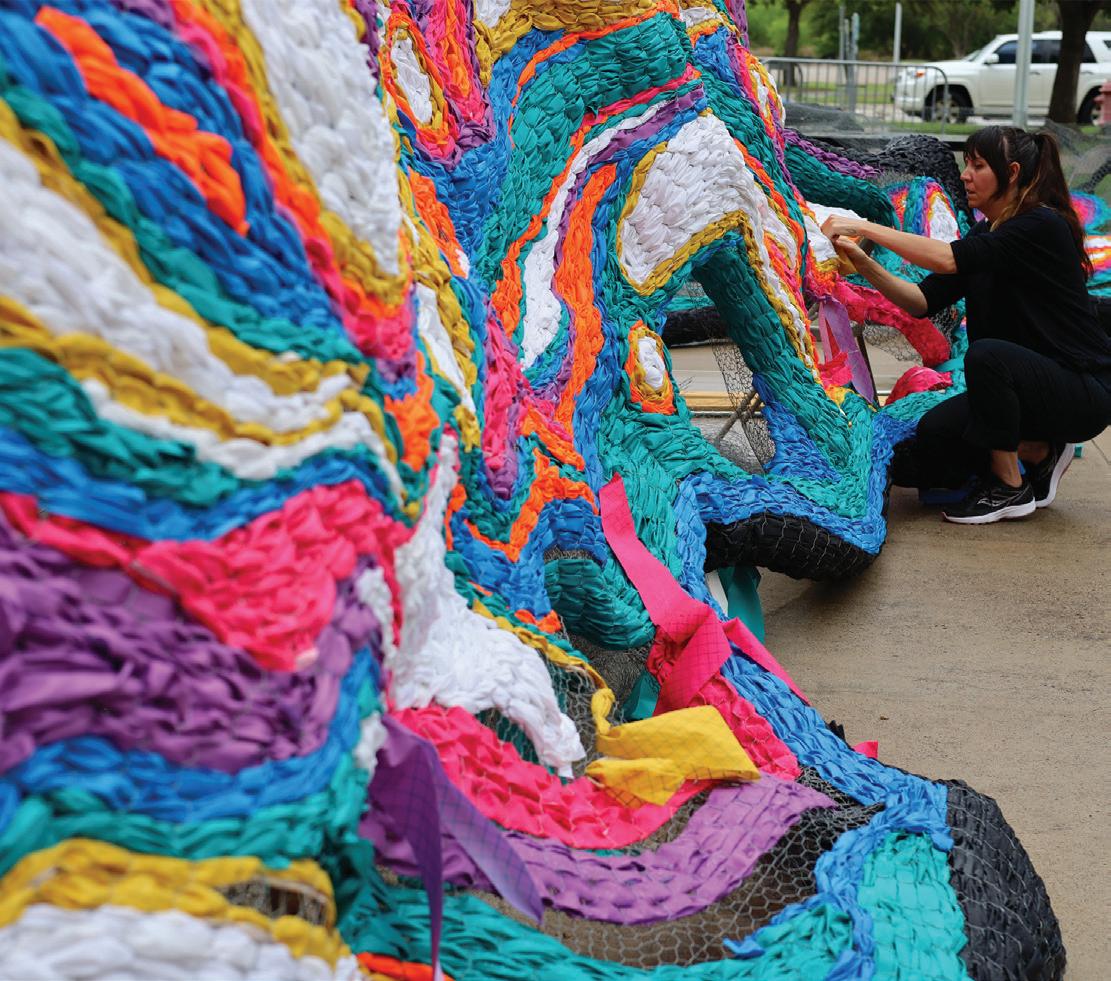
Recycled Plastic Bottles > Fabric > Art Installation > Reusable Grocery Totes > Reduce Waste
Through exploring shapes and forms found in nature on both a micro and macro level, I hope to engage the audience
12 APRIL 2024
Crystal Wagner, Visiting Asst. Professor of Art at TAMIU.
on a visceral level as visitors will be immersed in a symphony of sound, textures, color that are all woven into the Rhizome installation. In addition to its artistic and environmental effort, Rhizome embodies the spirit of collaboration and community engagement through partnerships with local organizations and initiatives. World building takes a village. Over the past two months, I have worked closely with students and faculty from TAMIU, with volunteers from the community including visiting groups of local middle school students, art clubs, Girl Scout troops and have hosted public printmaking workshops to create screen prints that incorporate marks from artists from the community into the full installation. In conjunction with the creative events, Rhizome has worked with the philosophy society to host: Art and Eco Philosophy: An Interdisciplinary Discussion presented by me and Dr. Jude Galbraith and opened a poetry contest to the citizens of Laredo that examines humans and nature in the modern world. The winner of the contest will recite their poem live during the full Rhizome event. Rhizome is about connecting the community at TAMIU and Laredo, by acting as a bridge between departments, disciplines, and the community.
From the intricate patterns I weave into the fabric to the meaningful dialogue established through contemporary dance choreographed by Tim Rubel and Nayeli Lopez, theater performances guided by Gilda Caballero that explore ecophilosophy, performed by the students in the theater program, the reciting of the winning poem from the poetry contest, original music created and performed by TAMIU music faculty and students, including: Colin Campbell and James Moyer; Composition performed by Jiyeon Hwang, Yi-Mei
Huang, Michael Mann, Javier Elizondo, Matt McVinnie, Carlos Castañeda, Emily Vachella, and Diego Martinez; and as well as the integration of more regionally specific music and dance forms with performances by the Mariachi group and Folklorico dance group.
With Rhizome, I hope to leave a lasting impression on all who encounter it. By harnessing the power of art and creativity in all forms, to advocate for environmentalism and sustainability, Rhizome invites us to reimagine our relationship with the planet and embrace a more harmonious way of living.
Join us on April 12th at Fine & Performing Arts Building at Texas A & M International University as we celebrate the unveiling of Rhizome and the accompanying performances that all center around human beings and their relationship with nature in the modern world.


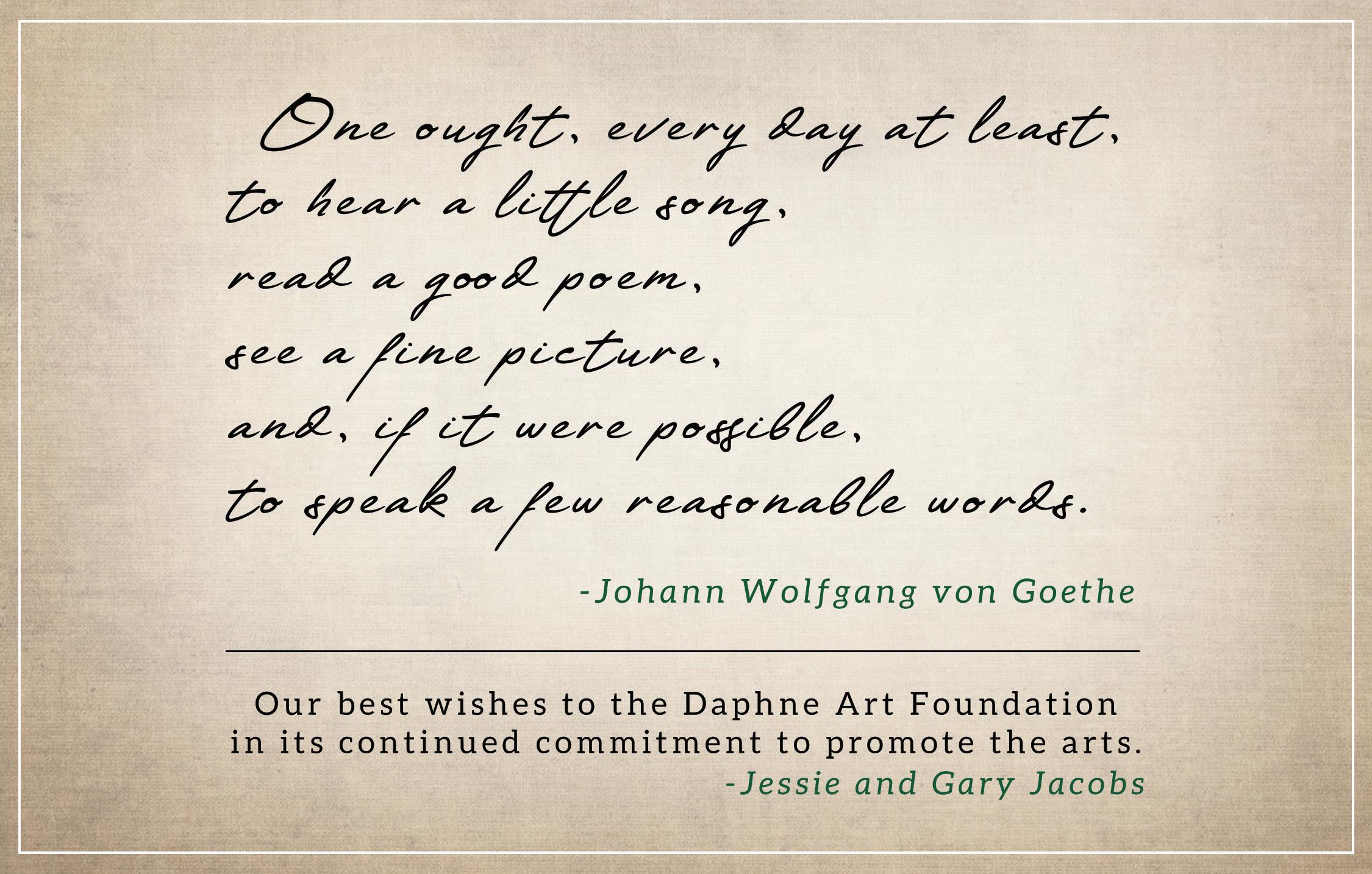
APRIL 2024 13
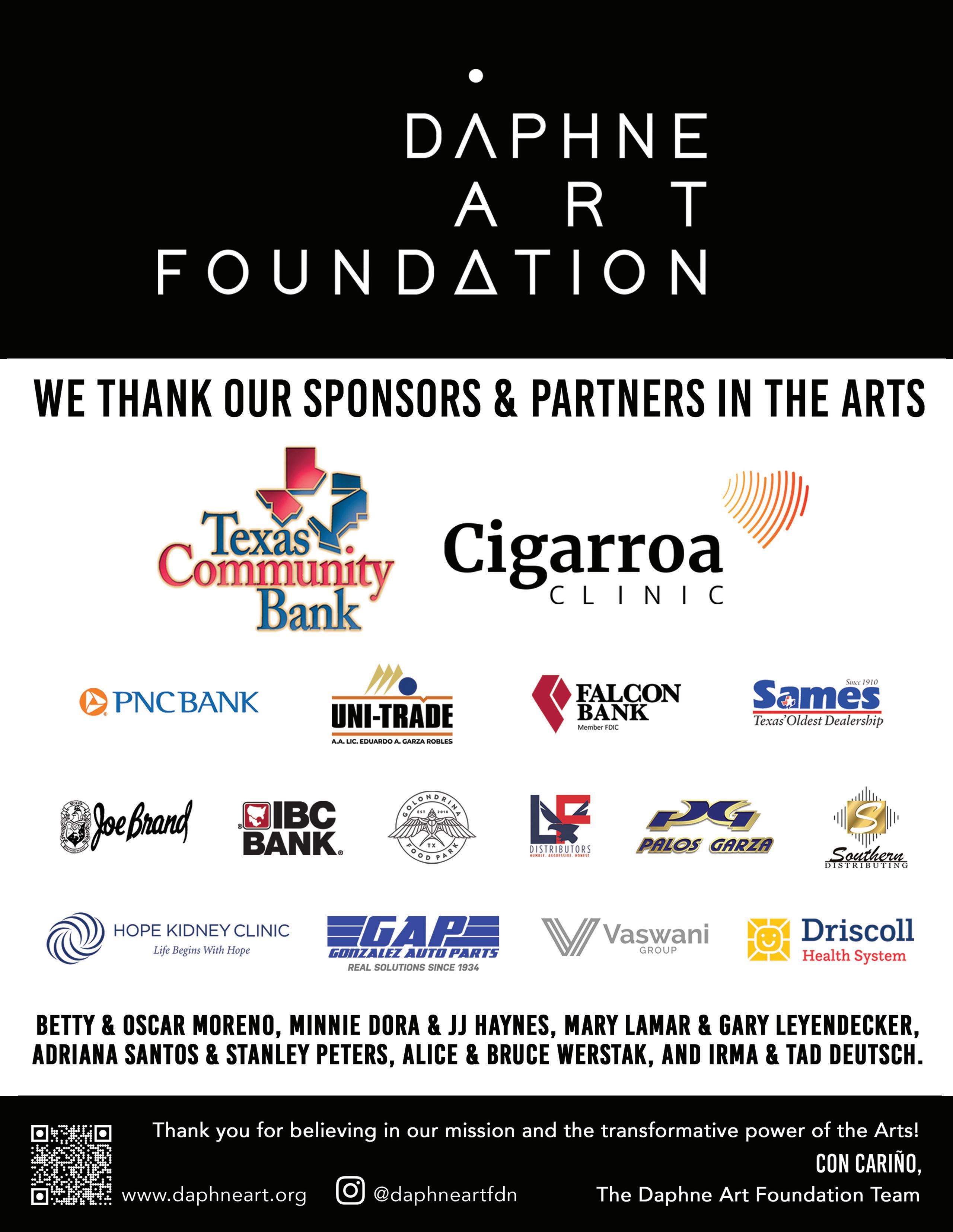
The Zacate Creek Creative Coalition: promoting
equity
through
arts and culture by providing a platform for diverse voices to shape healthier physical and social structures along the creek
Coalition engaged in work to help build community for the work ahead
BY MARITZA BAUTISTA
Did you know Zacate Creek is Laredo’s longest linear park? It is 10 miles long and stretches north from Barrio El Azteca, from the Rio Grande to Chicago Street in the Sal Si Puedes neighborhood.
Earlier this year, Daphne Art Foundation joined forces with a few residents who live along the creek; Somos del 8, a group of residents from District 8; and the Laredo Center for the Arts to reinforce the Zacate Creek Creative Coalition. The goal the Coalition adopted is to promote equity through arts and culture, and to provide a platform for diverse voices and perspectives to be heard to shape healthier physical and social structures along the creek.
This work is funded by a $100K grant received through Methodist Healthcare Ministries’ Prosperemos Juntos | Thriving Together (PJTT) program.
For six months last year, Daphne participated in MHM’s PJTT Learning Collaborative. During that time, the Coalition engaged in work to help build community for the work ahead. The Coalition hosted a pachanga at the basketball court in Azteca Park to meet the residents.
A community screening for El Azteca residents at the Laredo Film Society was followed by a discussion for connecting threads to be more civically engaged in the city. A creative placemaking workshop was facilitated by Nómada Estudio Urbano, a firm based in Cd. Juarez.
The aim of the Creative Coalition is to impact belonging and civic muscle through a project focused on civic engagement and participation through community arts. The Coalition is creating a learning cohort of 15 residents who live in the five neighborhoods along Zacate Creek to empower them to become informed leaders in their communities and to form a new artistic community outside of the traditional, more formal arts community.
The new artistic community is led by everyday people who may not prioritize the arts, know about the arts, or consider themselves to be creative or artists. Their participation in the cohort will lead them to create, present, and integrate the arts within their neighborhoods in places not considered spaces of art - for example, laundromats, convenience stores, taquerias and other spaces where people gather. This will happen with the support of the Creative Coalition.
During five months, the cohort will participate in creative placemaking activities, workshops and leadership-building training, attend City Council and other local meetings that will allow them to gain knowledge about government, and how people and decision-making shape it, and participate in art-
making alongside local artists with whom they will share their experiences with.
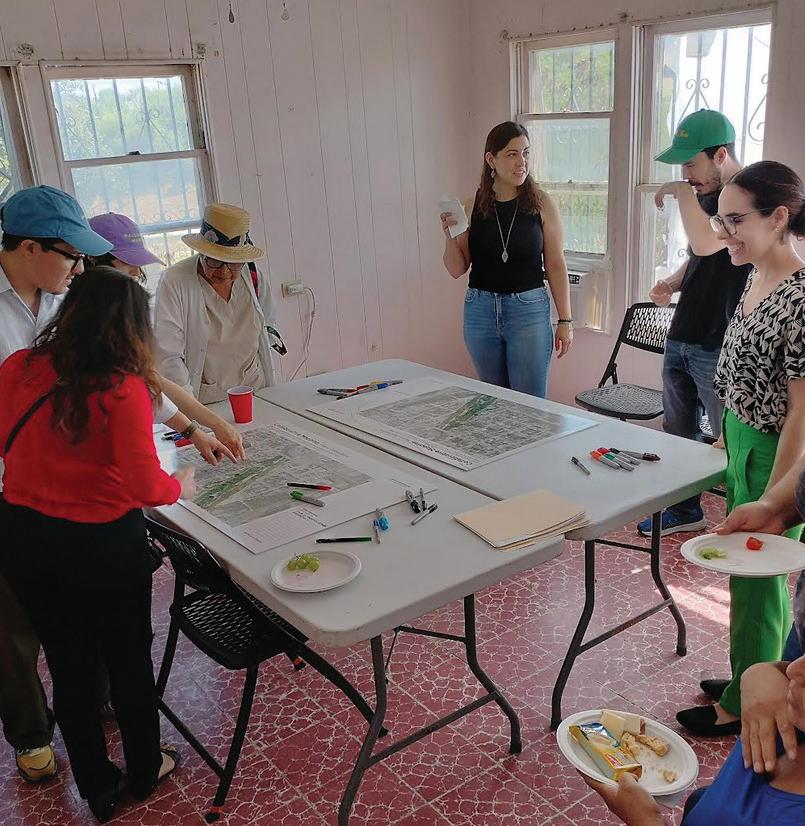
Planning
There is much value in this work. The Creative Coalition’s goal is to help implement community-oriented arts participation by taking this grassroots approach to help strengthen community bonds and allow people with their unique lived experiences to step into their power as active participants in their communities and help improve their health. By looking at and making art, and using the techniques of creative placemaking and placekeeping, the residents who live along Zacate Creek will achieve strength and fortify their sense of pride and belonging through arts equity and civility.
Toward the end of this year, the Zacate Creek Creative Coalition will present the cohort’s artwork during community exhibitions within the five neighborhoods along the creek and other public spaces. The cohort will take the lead on other public art events for the public to enjoy and from which to learn.
(Maritza Bautista is a member of the Zacate Creek Creative Coalition and the Executive Director of Daphne Art Foundation.)
APRIL 2024 15
with members of Nómada Estudio Urbano.
ARTE PÚBLICO
El Abrazo
by Sandra Gonzalez
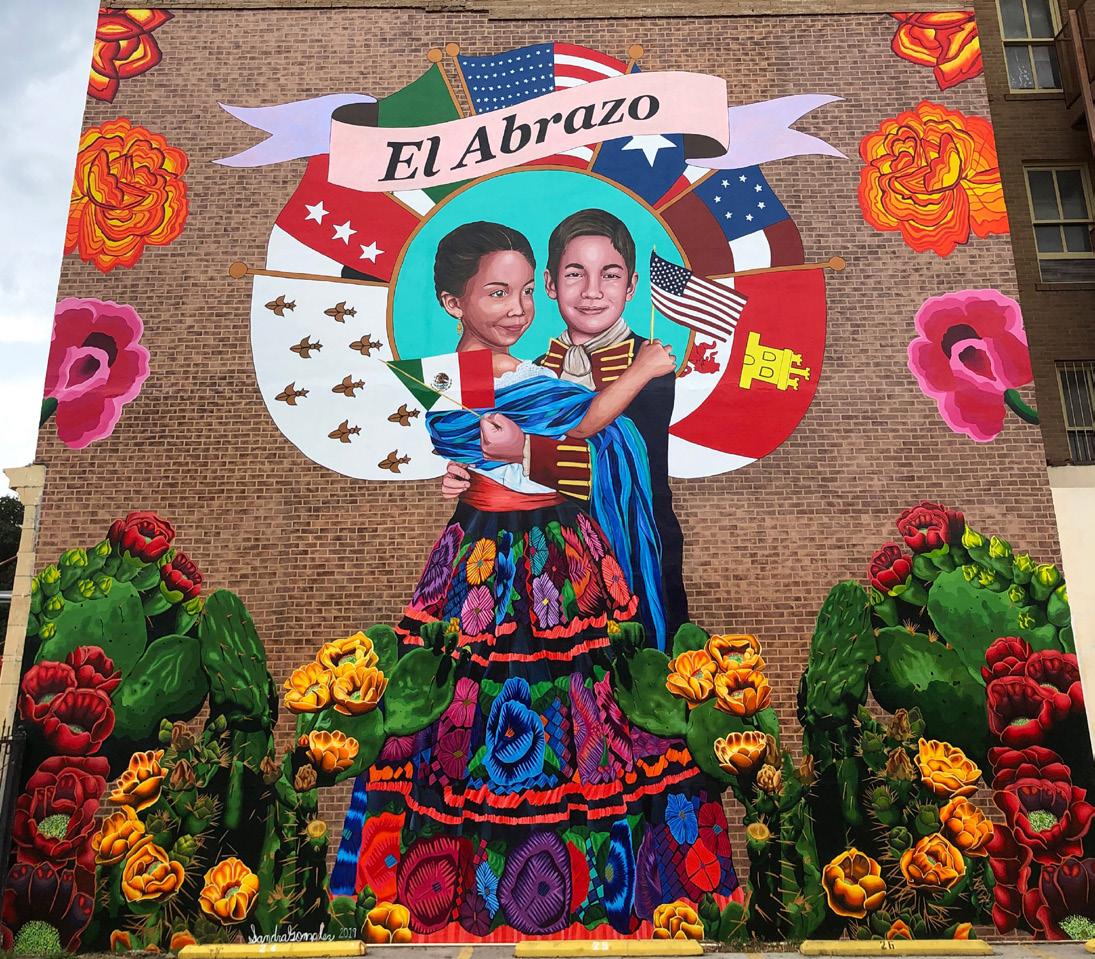
Sandra Gonzalez writes:
“I have lived in Nueva Cd. Guerrero, Tamaulipas; Laredo, Corpus Christi, Philadelphia, and now San Antonio. Laredo is and will always be dear to my heart. This is my hometown where most of my family lives. I began teaching art at J.B. Alexander High School.
“‘El Abrazo’ is in my top three favorite murals. It is special to me because it is a representation of unity, heritage, hope, and friendship between Laredo and Nuevo Laredo. It depicts the moment of “embrace” between our cities during the WBCA festivities, a moment in which the International Bridge becomes a meeting place instead of a dividing line. In that moment of embracing, we are one.
“The mural measures 37 ft. x 36 ft. and took nine weeks to complete. I hired a team of artist friends and former students to assist me. I lived in Corpus Christi while creating the mural, teaching at West Oso High School. Most of it was painted in a studio. This was possible because the majority of my murals are painted on treated fabric panels that are installed when the mural is completed. This technique that I learned in Philadelphia has proven to withstand the elements over a period of 15-20 years.
“My time in Philadelphia was essential to my art career. It is where I earned an MFA degree to learn about public art from the most respectable mural arts program in the country. I am blessed to share a passion for transforming spaces through public art with my husband Malachy McKinley.
“I am fortunate to work as an art educator because I can inspire others to find their voice through art. I teach at Roosevelt High School in San Antonio, and this is my 10th year teaching art. I am thankful for the opportunity to create the ‘El Abrazo’ mural. Many thanks to former Council member Roberto Balli, Tomás Izaguirre, WBCA Laredo, and the City of Laredo for making this project possible. “
El Azteca “COLORES DE MI BARRIO”
Students of the Vidal M. Treviño School of Communications & Fine Arts; instructor Jorge Vasquez
Artist Nansi Guevara reflected on her work in 2003 on the mural in the El Azteca neighborhood while a student at the Vidal M. Trevino School of Communication and Fine Arts. The effort was led by VMT art instructor Jorge Vasquez. The 2003 mural covered the one Vasquez and his Memorial Middle School students painted in 1991.
This is Nansi Guevara’s recuerdo:
“This was the first time I painted outside on a public wall. It was a formative experience. I wanted to be a community-oriented artist. It was one of the starting points of understanding that art and activism could be the same. A lot of the narrative in Laredo was about immigration, border security, and the very present Border Patrol.
“Working on the Azteca mural helped me have a true reflection of my own neighborhood and our history. I learned about the figures we were painting, who they were in our history – Cesar Chavez and the United Farm Workers, Emiliano Zapata.
“We were painting a monument. The experience itself was monumental as I recognized the value and cultural significance of the Virgen de Guadalupe in the Chicano and Farm Worker movements, and also the significance of the Matachines and the folklorico dancer on the mural.
“The border is not about Border Patrol and the militarization of the border. It’s about people, culture, and movements. The mural became a true reflection of my community, a monument to our true history.
“The experience of working on the mural was the beginning of my critical thinking as an artist and a person. Having expressed myself in art in a public space told me that I had value.”
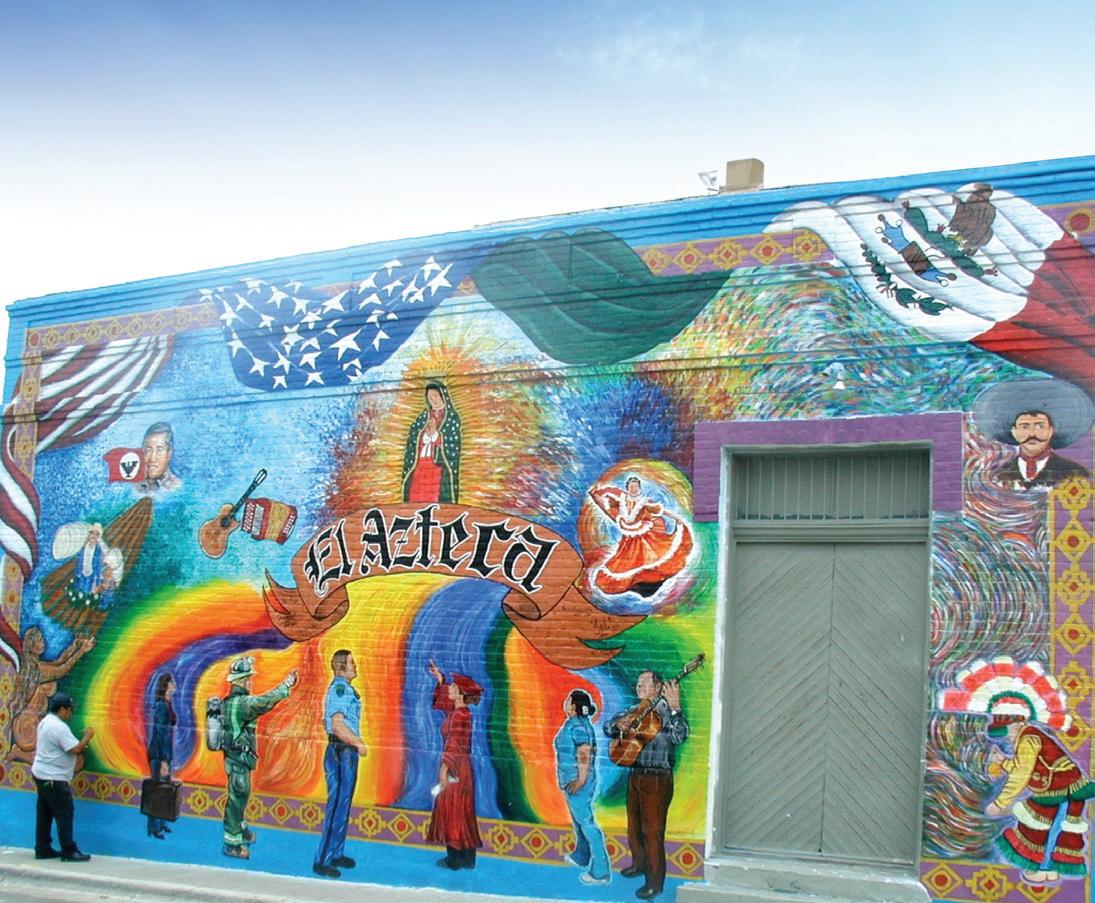
16 APRIL 2024
2019 - Old Sames-Moore Building - 1219 Matamoros
2003 - San Pablo Ave. at 20 Iturbide St.
Congratulations, Raquel Valle-Sentíes
2024 - 2026 City of Laredo Poet Laureate
Growing Up en Laredo
Chicana, Pocha, Tex-Mex, Mexican American, Latina, Hispanic. So many labels. Which one should I use?
They’re all the same to me.
Yo nací en el border.
En Laredo as a matter of fact.
Había pocos gringos.
They were a minority.
Hasta la fecha they still are.
Nadie tenía labels, or I was unaware of them. We were all Americans, unos gueros, otros morenos y crecí talking like this.
El get-together ya empezo.
Los guys ya estan llegando.
Prestame tu lipstick, el Fire and Ice que está bien rojo. Is my crinolina hanging out?
Que va, you look bien padre.
Me aprieta mucho el Merry Widow. I think I’ll take it off.
No huerca, te hace very muy sexy. On Sundays íbamos a morning mass.
No había en la tarde mucho menos on Saturday que te valiera for Sunday. A la una we’d go al centro a ver the latest movie, al Tivoli o al Rialto, al Plaza o al Royal despues al City Drug a flirtear con los huercos, comer French Fries con gravy, tomar un-Cherry Coke, pasar all la tarde. El hangout de los gringos era el Central Drug. We never went there. Discrimination I suppose but of our own accord.
The guys would whisper de Conchita’s Place across the river. We were dying to ask about it But nadie se atrevía. Let’s go and eat cabrito con frijoles bien borrachos. There was no such thing as Nachos Patos, or Burritos. If you asked for a Mariachi, you got a band cantando rancheras.
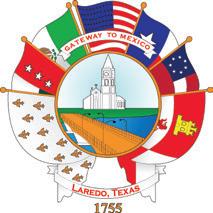
En St. Angela’s Hall debajo del eagle eye de la Gerarda y la Gabriela bailábamos cheek to cheek to the tunes of Joni James and Nat King Cole. Echábamos estilo con el clasico danzón y el Mambo #5. Growing up en ese tiempo fue una cosa bien bonita without having all those labels pa complicar más las cosas.
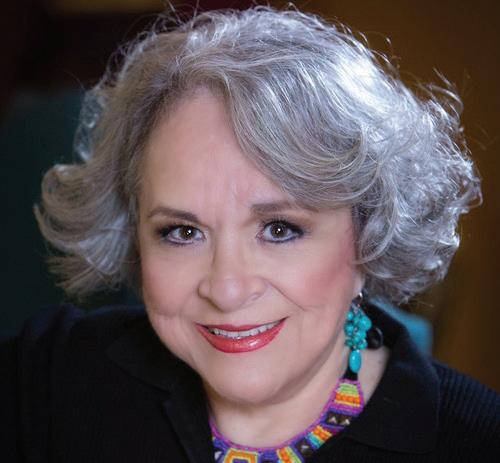
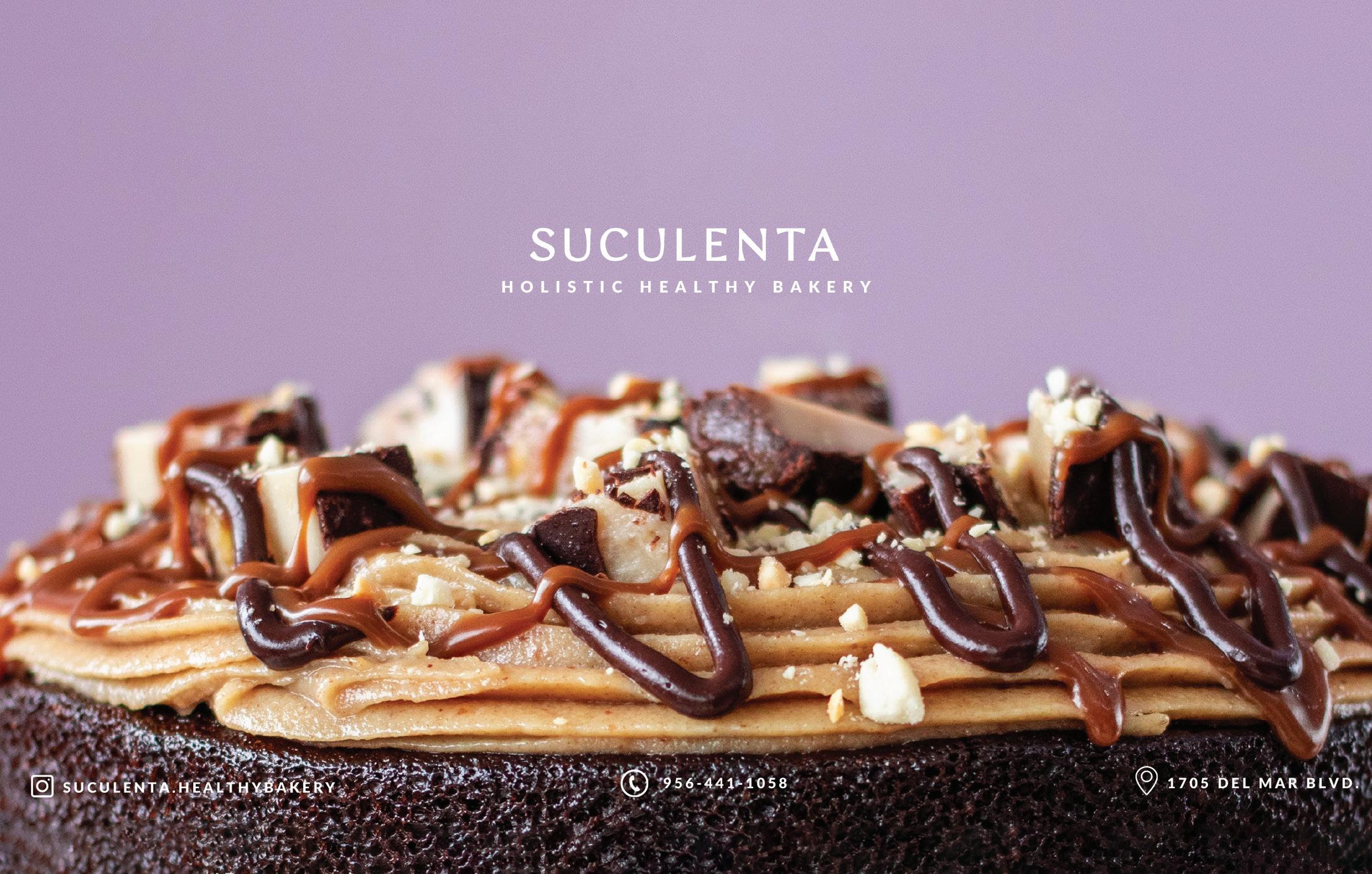
APRIL 2024 17
A new direction for the Laredo Center the Arts
A more contemporary and multifaceted experience than has ever existed in this historically traditional space, with bold installations, performance art, experimental video, interactive workshops, and even augmented reality
BY RYAN CANTU
Another landmark year at the Laredo Center for the Arts (“LCA”) was wrapped up by Los Outsiders, the Austinbased collective consisting of Hector Hernández, Michael Anthony García, Jaime Salvador Castillo, and Roberto Jackson Harrington. The exhibit’s title, Chai’n Brai Laika Daimon, is a nod to one of the underrepresented voices Los Outsiders tries to elevate: the unique yet much-derided language of the South Texas border.
The Los Outsiders’ exhibit symbolizes the LCA’s recent new direction towards a more contemporary and multifaceted experience than has ever existed in this historically traditional space, with installations, performances, experimental video, interactive workshops, and augmented reality.
The LCA’s new direction has its roots in the pandemic years that spawned the Art Acquisition Project, which invested in bringing long-lost Laredo artists to exhibit back home and purchasing their art, most notably Blue Bato con Sunglasses by Chicano icon César Martínez.
For the past couple of years, the LCA has consistently invested in similarly bold exhibits that rotate quarterly, in addition to smaller exhibits on the second mezzanine level that houses the LCA’s growing permanent collection of local artists’ work. This approach is geared towards securing new sources of funding through grants from organizations like the Mellon Foundation, with an ultimate goal of establishing Laredo’s first contemporary arts museum.
LCA’s investments in regular comprehensive exhibits has occasionally undercut its longtime reliance on rentals to outside groups. This resulted in differences of opinion as to how to move the organization forward with a cashstrapped budget, which ultimately led to changes to the LCA’s leadership and staff in late 2023.
The changes at the LCA involved the unfortunate departure of Rosie Santos, the former Executive Director who helped foster a new approach in which recent artists have been given a blank slate in how to exhibit their work with little pushback or micromanagement from the organization. Last year, Santos was heavily involved with Eric Avery’s hit exhibit Art as Medicine, which included provocative sexual imagery like large nipple installations that popped out of the walls. According to longtime members of the LCA, this type of exhibit may not have flown with a more conservative LCA of years’ past.
While a leaner LCA works overtime to keep the organization afloat, one unmistakable change is a more artist-heavy board. Local artist Gil Rocha recently assumed the role of Interim President, complemented by an all-artist staff that gives visitors a sense of the new blood as they enter the space. The staff includes Interim Executive Director Bruno Rendon, who enthusiastically gives visitors a personalized tour of the
space and the various new initiatives that are taking the LCA beyond a mere gallery space.
“When these changes happened with the Center, there was a lot of uncertainty,” said Rendon, “but the only certainty that I knew was that we need to continue to have people coming to the center. The show must go on.”
One of Rendon’s most recent initiatives is Art Couch, a side-exhibit that allows visitors to take a break from the main exhibits, take a seat, and reflect on local artists. The project began in August of 2023 with photographer Gaebrial Velasco, a member of the Laredo Film Society that is housed in one of the LCA’s suites. Art Couch has since rotated new artists monthly, currently displaying the cross-border photography of Pepe García that will be available until the end of March.
On the day I visited Los Outsiders’ exhibit in late December, there was quite a buzz around the center with a visit by Dr. Claudia Zapata, the first curator of Latinx art at the Blanton Museum of Art in Austin. This kind of outside recognition can be surprising to Laredoans, who are conditioned to feel unworthy, living in an inferior in-between place, perpetually in the shadows of the greener pastures of San Antonio/Austin to the north and Monterrey to the south, and relying on these outside places for a sense of culture and identity.
The LCA’s recent exhibits show that Laredo is a creative force unto its own, with its artists imagining new and different realms that are breaking free from the dominant border story defined by refugees in despair.
“You can’t talk about Latine art and not talk about the borderlands,” said Claudia Zapata. “There needs to be more effort in general for Central Texas to go to these places.”
The interest of outside curators and artists comes at a critical and exciting time for Laredo, allowing the thriving grassroots artistic movement here to benefit from a more inclusive curatorial approach from outside. According to Los Outsiders’ Hector Hernández, this emerging symbiosis between forces within and without would not be possible without the time and investment from organizations like the LCA. In January, Los Outsiders pitched an idea to rent a large van to take a group of collectors and curators from Central Texas down to Laredo. The LCA was fully on board.
“That’s another example of the LCA really stepping up,” Hernández said.
With 2024 full of excitement and uncertainty, the LCA will spend another year forging its identity as a unique artistic space that is not quite a museum and not quite a gallery. Instead, it is more like an open canvas. Or as Claudia Zapata put it, “a good space for everything to breathe.”
18 APRIL 2024
* * *
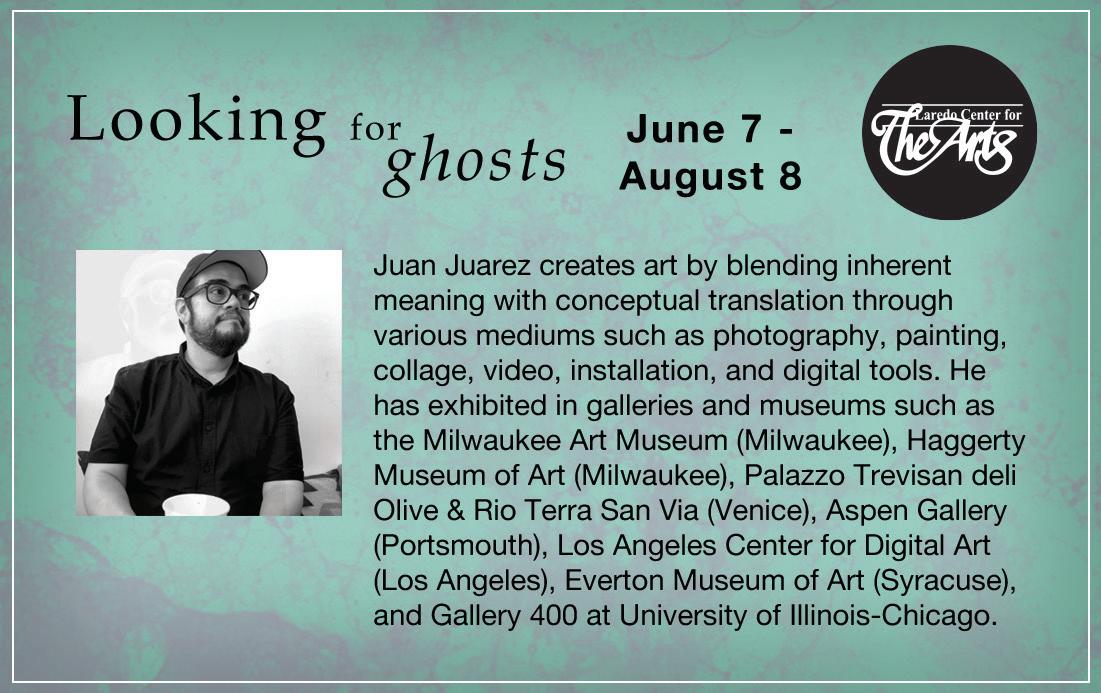


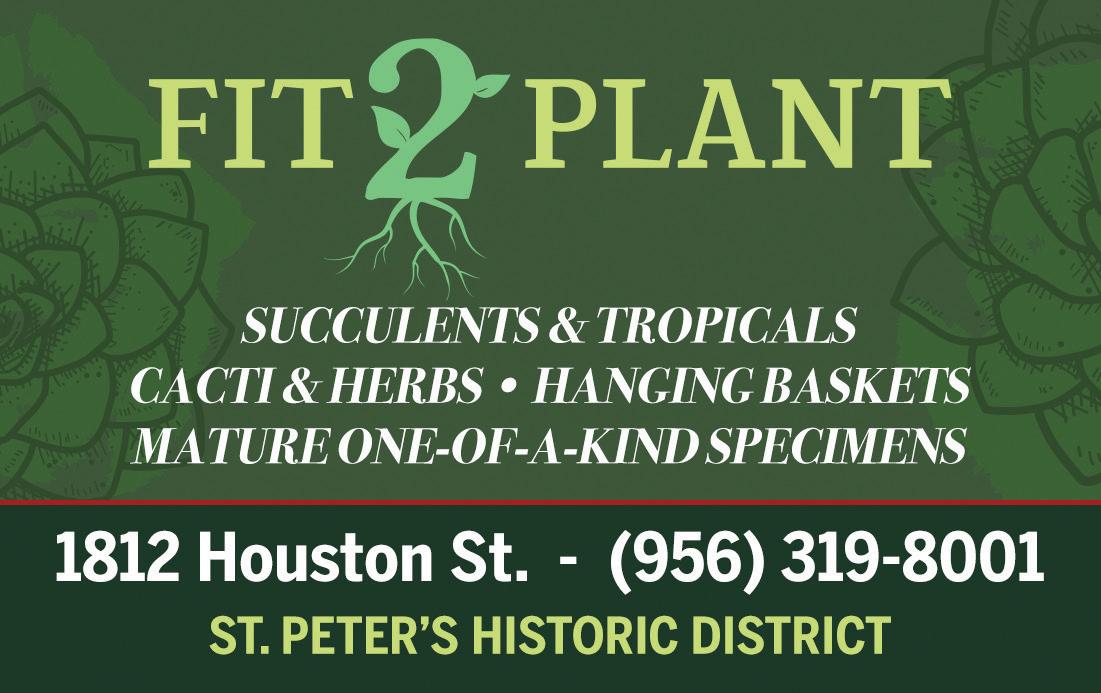
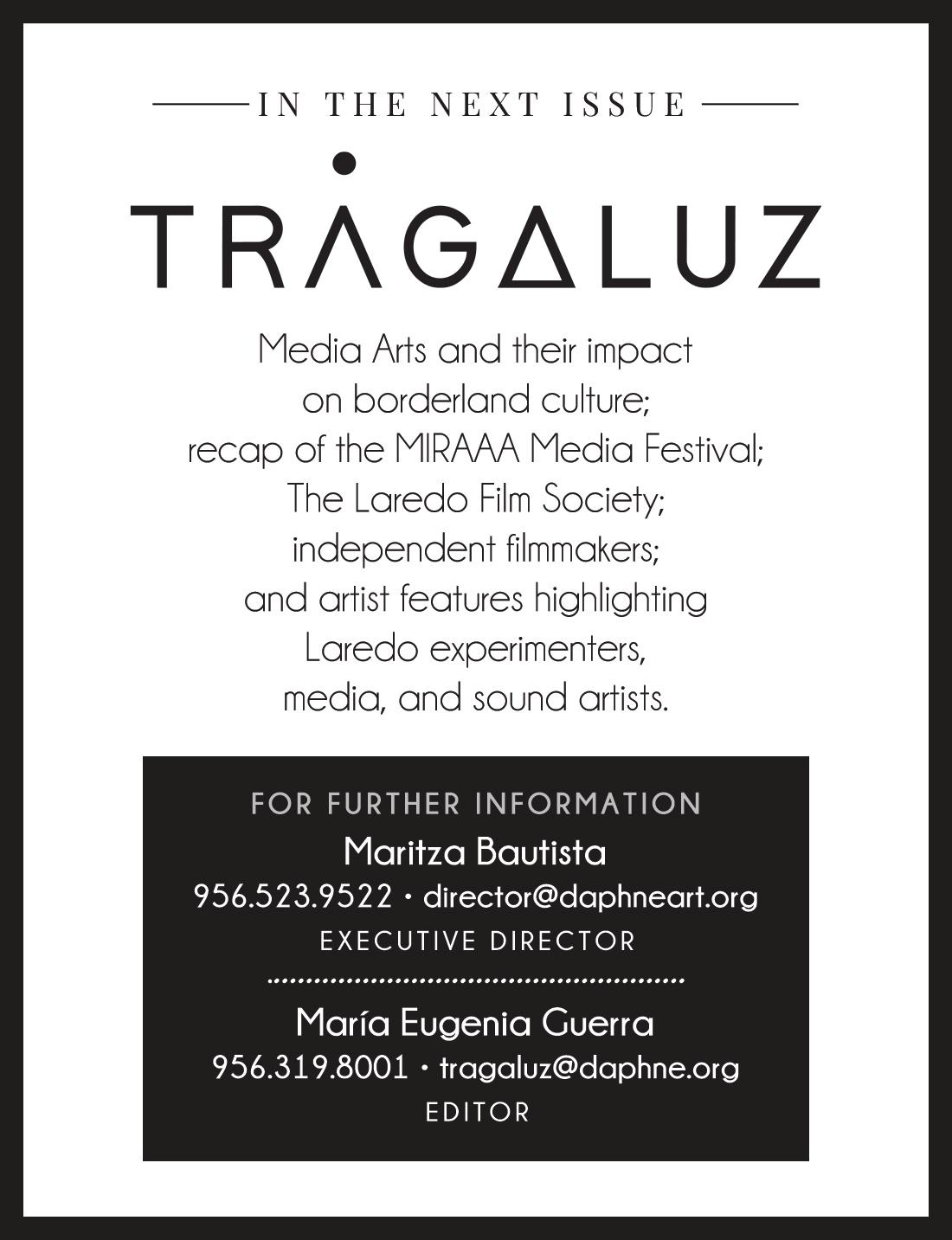
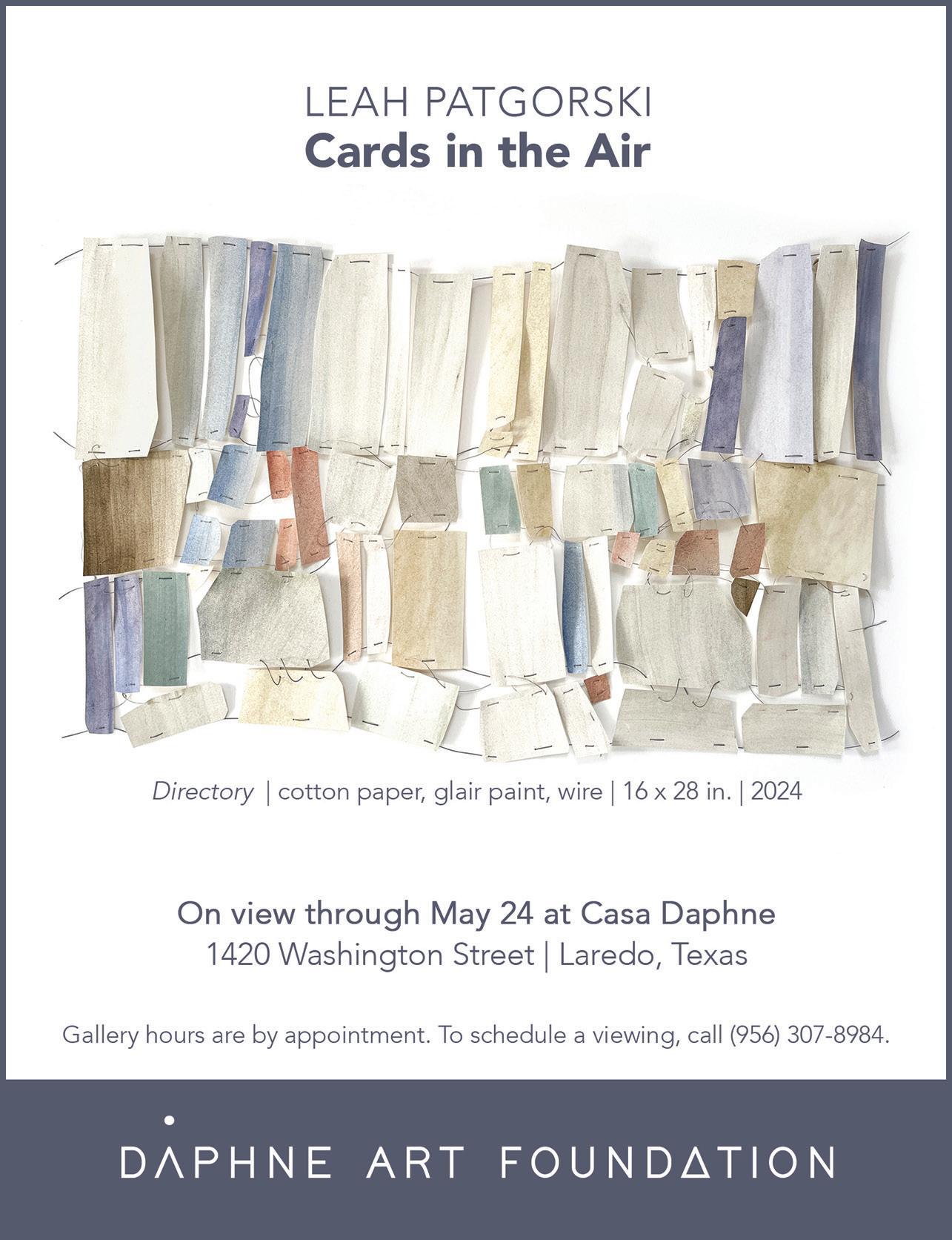
APRIL 2024 19
TAMIU:
A vibrant hub for art, music, dance, and more! Folklorico, chorale recital, orchestra, percussion, mariachi, jazz, guitar ensemble
Texas A&M International University’s (TAMIU) Center for the Fine and Performing Arts (CFPA) is a hub for musical and dance performances and many ongoing artist exhibits throughout each semester. A series of performances, concerts, and exhibitions are planned at the CFPA.
Event time, date, and location listings are subject to change – a complete, up-to-date event list is posted at https:// go.tamiu.edu/cfpa-events. Unless otherwise noted, all events are free and open to the public.
Among the upcoming performances are:
• Spring Dance Concert – Fri., Apr. 5 at 7:30 p.m. in the CFPA Theater. Performances from Ballet Folklórico to Contemporary Dance genres.
• Choir & Voice Studio Annual Recital – Tues., Apr. 9 at 7:30 p.m. in the CFPA Recital Hall. .
• TAMIU Orchestra Performance – Wed., Apr. 10 at 2 p.m. in the Student Center Rotunda
• Percussion Ensemble Recital – Wed., Apr. 10 at 7:30 p.m. in the CFPA Recital Hall
• TAMIU Orchestra Recital: Sounds of Mexico – A Mexicanthemed orchestral performance Tues., Apr. 16 at 7:30 p.m. in the CFPA Recital Hall
• Jazz Band Performance – Wed., Apr. 17 at 12:10 p.m. in the Student Center Rotunda
• Mariachi Internacional Spring Concert with Mariachi Nuevo Tecalitlán – Fiesta del Mariachi – Thurs., Apr. 18 at 7:30 p.m. in the CFPA Recital Hall The University’s Mariachi Internacional will feature many much-beloved traditional mariachi songs.
• Jazz Band Concert – Tues., Apr. 23 at 6 p.m. in the Center for the Fine and Performing Arts Theater. Band members will perform an eclectic mix of traditional and contemporary jazz pieces.
• Music on the Menu – Wed., Apr. 24 at 12:10 p.m. in the Center for the Fine and Performing Arts Recital Hall
• Guitar Ensemble Recital – Wed., Apr. 24 at 7:30 p.m. in the Center for the Fine and Performing Arts Recital Hall
• Symphonic Band Concert – Fri., Apr. 26 at 7:30 p.m. in the Center for the Fine and Performing Arts Recital Hall. The culminating performance of the University’s Symphonic Band.
• Rhizome is a multidisciplinary contemporary art project

organized by TAMIU visiting assistant professor of Art Crystal Wagner. It was created on campus this Spring 2024. Its culminating performance on Fri., Apr. 12, 2024, at 7 p.m. will feature musical, dance, and theatrical performances, and an unveiling of the Rhizome largescale art installation. The project involves collaboration between faculty and students in the art, dance, humanities, music, and theater, and the community at large. For more information on Rhizome, visit go.tamiu.edu/rhizome.
The Helen Richter Watson Art Gallery on the first floor of the Sue and Radcliffe Killam Library embraces the empathic spectrum of her profound influence as both artist and teacher. The Gallery replicates Watson’s welcoming Houston Street studio, which openly mixed works of art within her home to create a gathering space where the artist celebrated, lived, and worked her art daily. The Gallery is a gift of legacy and love made possible by the Dolly Richter Watson Foundation.
The latest information on upcoming performances are on Facebook at https://www.facebook.com/ TAMIUCFPA and Instagram at https://www.instagram.com/ txamiuperformingarts/.
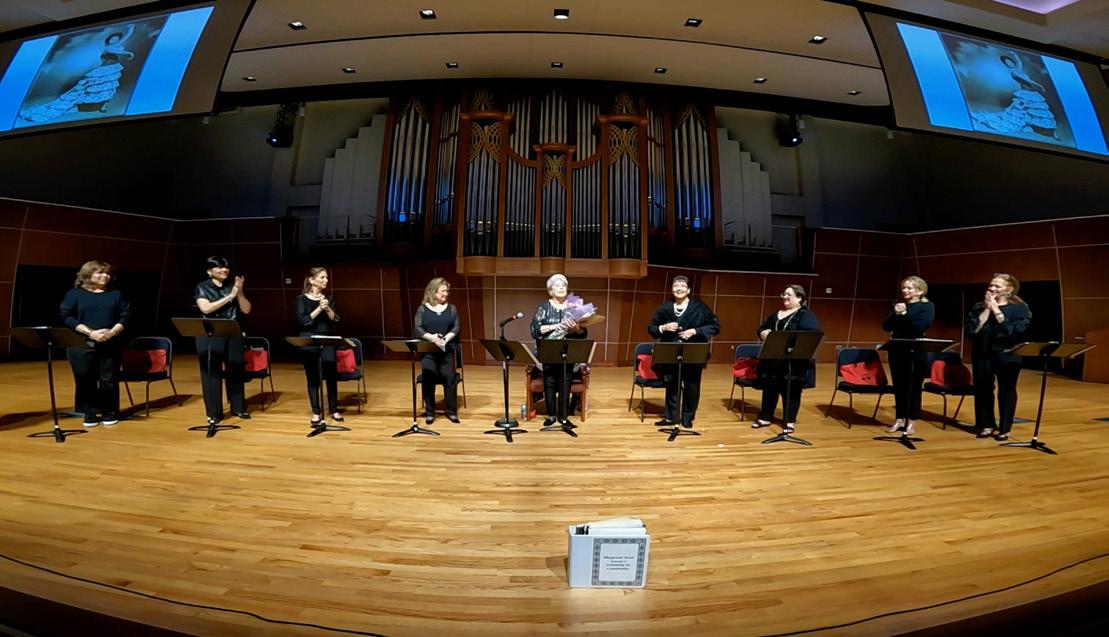
Ever gracious, cultural icon Altagracia Azios García (center), thanked the audience at the February Castañuelas performance at the TAMIU Center for the Fine and Performing Arts Recital Hall. Other members of the group included (left to right) Anna Isabel Alvarez, Dr. Carmen Rathmell, Elvira Jackson, Lizzie Villarreal, Sandra Muñoz, Shawn Young, Tracy Sanchez, and Jackie Jacaman. The performance was part of TAMIU’s “Music on the Menu.”
20 APRIL 2024
A Fearful Joy: Krueger exhibition opens April 11 at San Antonio’s Hunt Gallery
“We can barely look at the breathtaking, extraordinary, astonishing beauty that surrounds us on this world we’ve made.”
BY MARÍA EUGENIA GUERRA
An exhibition of Janet Eager Krueger’s A Fearful Joy opens with a reception Thursday, April 11 at the Hunt Gallery in San Antonio from 6 to 8 p.m.
With eyes and heart open wide to the solace and beauty of the South Texas ecosystem that is her home and that informs her work, Krueger says she paints from el monte adentro.
Her friend Sean Chadwell, formerly a professor of English at TAMIU, said of her art, “….. this work transcends local color. For Janet the creative process is one of assembling bits and pieces - of stories, sketches, old photographs, Greek mythology - into work greater than the sum of its parts. Surprising, occasionally unsettling, juxtapositions result, and the imagery of the Texas ranch resonates universally... reminding us that everyday life in South Texas, like everyday life everywhere, has depths, - narrative, cultural, spiritual - worth attending to, scrutinizing.”
The upcoming exhibit consists of nine botanicals and landscapes that range in size from 5”x7” to 9”x12.” Larger canvases, including A Fearful Joy are 5’x7’ at the largest.
Janet Krueger is an articulate wordsmith possessed of refreshingly concise expressions in conversation and the printed word. She writes that “a fearful joy” as the title of a work of art and this exhibit, is attributed to a phrase in a stanza of British poet Thomas Gray’s “Ode on a Distant Prospect of Eton College”: Some bold adventurers disdain
The limits of their little reign, And unknown regions dare descry: Still as they run they look behind, They hear a voice in ev’ry wind, And snatch a fearful joy.
-Thomas Gray
Though she spares few words in her artist’s statement of the horrific, unprecedented environmental events fomented by climate change - worldwide floods and fires - she writes, too, of the tender, persistent beauty of the world she inhabits.

A Fearful Joy
Artist’s Statement
3-21-24
“Time passes and we watch and marvel. The peoples of the world, rich and poor, stagger before mighty oceanic waves crashing relentlessly on suddenly fragile shores. Populations shift in response. Unprecedented heat drains water resources, and fires scorch swathes of rangeland, forests, and homes.
“Time continues as ever, but now the patterns are unfamiliar. The old rhythms of the seasons are forsaken. We laugh and say nervously to our friends and to ourselves ‘What’s up with this crazy weather?’ - when we really know the answer.
“Still, the planet is awesome in its response to the assault we press upon it. The world IS awesome and all the life upon it is as well.
“Like the car wreck on the highway or the blazing building down the street, we can barely take our eyes away. At the same time, we can barely look at the breathtaking, extraordinary, astonishing beauty that surrounds us on this world we’ve made.
“It is with a fearful joy that I document this tiny, tiny patch of earth on which I live and breathe. I can barely look, but even so I see.”
The Hunt Gallery, which is at 4225 McCullough Avenue, will host an Artist Talk Saturday, April 27 from 1 to 2 p.m. The exhibition continues through May 11.
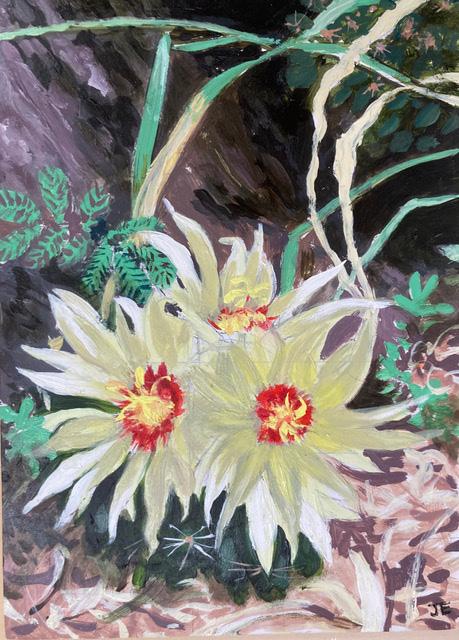
APRIL 2024 21
The Flowers that Bloom in the Spring, Tra La Oil on canvas, 45” x 60”
Mammalaria Heyderi Oil on paper, 7” x 5”
Who Was Martha Fenstermaker?
BY MARÍA EUGENIA GUERRA
The Martha Fenstermaker Memorial Gallery at Laredo College was named after a woman who had much to do with the foundation upon which the arts curriculum of the College was built over the 30 years that she taught there from 1983 until 2013.

Known for her genteel, refined demeanor and her lifelong romance with the arts, she was simultaneously a conservation rancher who raised registered Longhorns with her sisters, Bebe and Sissi, on the family’s historic Maverick Ranch, an idyllic Hill Country oasis. She was part of that enterprise until her death in 2014.
The Fenstermaker sisters, fierce champions for the preservation of wildlife habitat for endangered species and the conservation of natural resources, prevailed in legal eminent domain battles with the Texas Department of Transportation, state and federal agencies, and water districts that eyed the Maverick Ranch - listed in the National Register of Historic Places - as a fit site for the needs that suburban encroachment engendered for highway expansion, a dam, and a reservoir.
Their conservation efforts are documented in the oral histories of The Texas Legacy Project and Enduring Women: A Photography and Oral History Exhibit housed in the Bob Bullock Library in Austin.
There was much to admire about Martha Fenstermaker. She was well-read and erudite. The family histories of the Fenstermakers, the Greens, and the Mavericks that she recounted were the genetic blueprint for how she and her sisters came to be humanitarians, good stewards of their land, and advocates for human rights, civil rights, and free speech.
Many of her former students recall that she was an inspiring instructor, encouraging and generous with her time. While Chair of the LCC Art Department she recruited faculty that broadened the scope of instruction.
Fenstermaker, window maker. Martha gave those drawn to the cast of her bright light the gift of a window to see the beauty of the natural world as she saw it, and a window to peer into the soul of this rare human being grounded by her love of art, the blessed music of birdsong, and the deep, lasting relationships valued by those of us who counted on her loyalty and support.
By example, she presented us, too, with windows to look inward to rise to our better selves.
Inolvidable. Unforgettable. The vast reach of Martha Fenstermaker’s good life persists indelibly in many hearts.
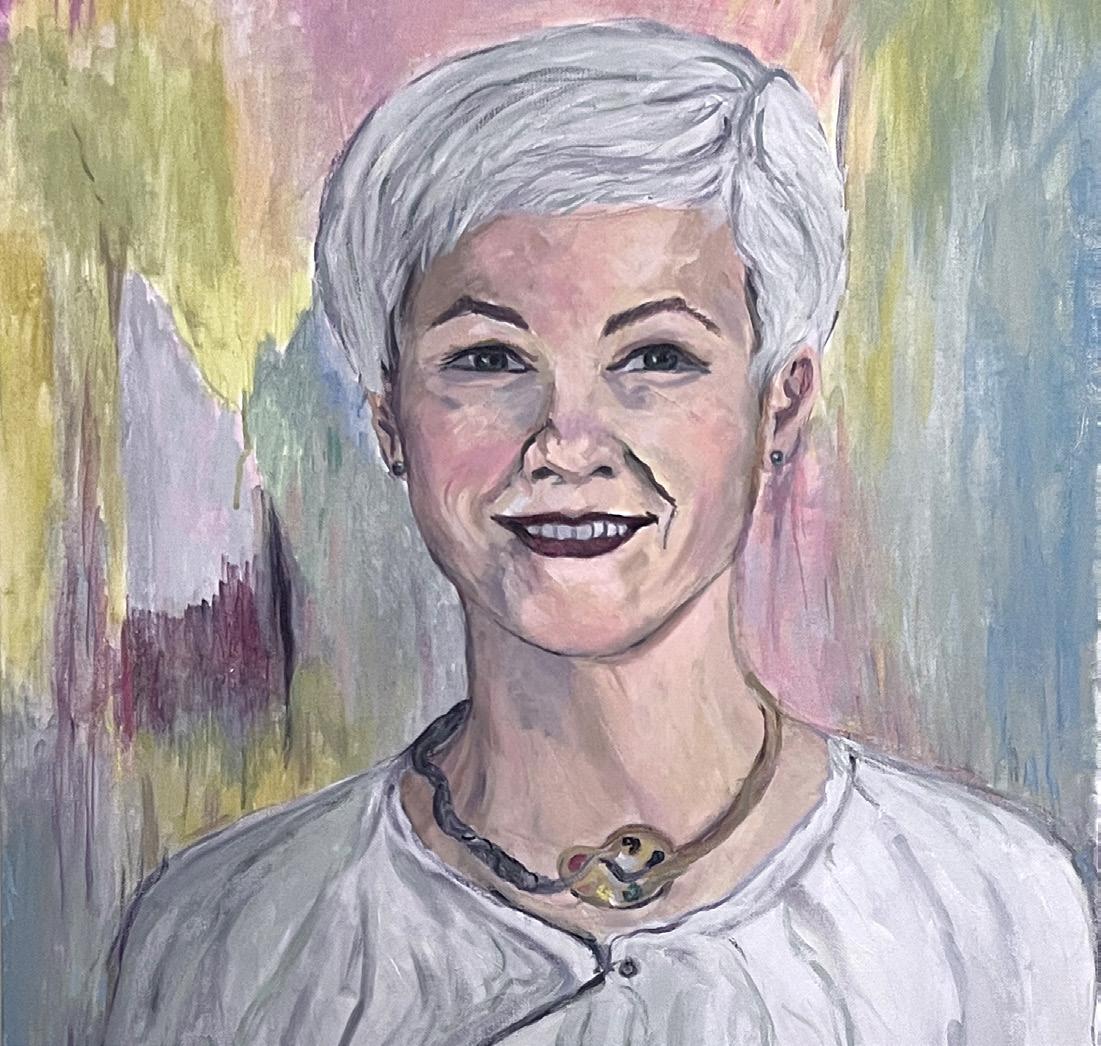
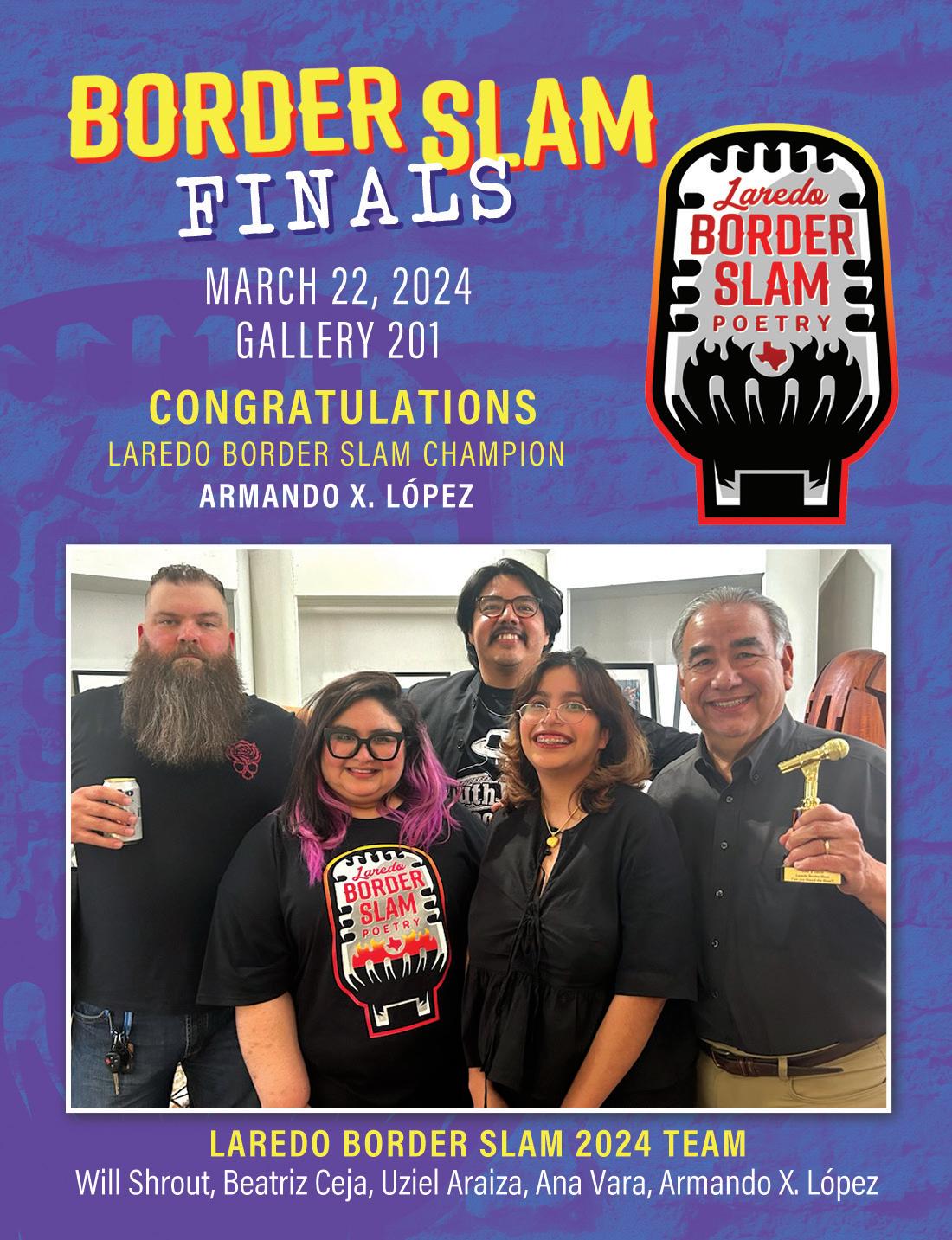
22 APRIL 2024
Martha Fenstermaker by Blanca Peña, a former student
